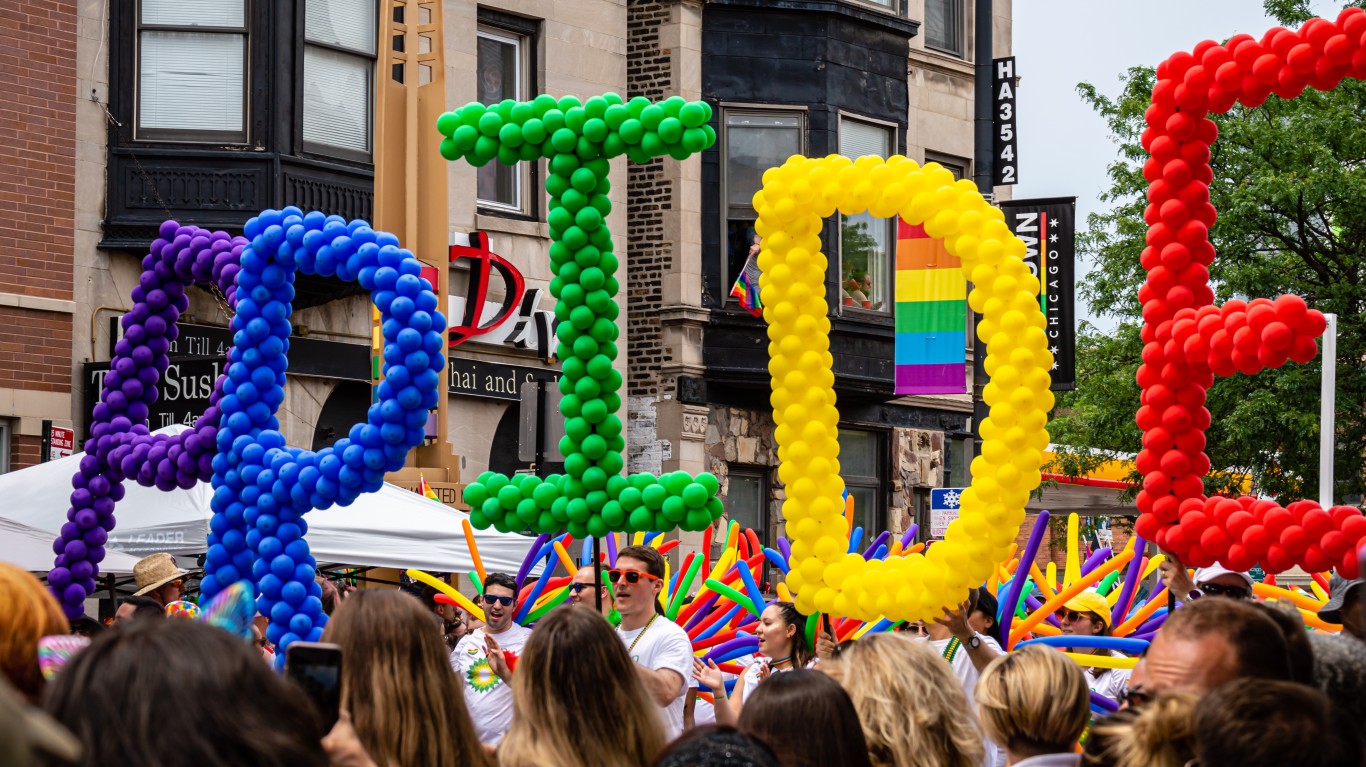
In a 6-3 vote along ideological lines, the U.S. Supreme Court ruled on June 30 that Colorado website designer Lorie Smith has the right to deny wedding-related services to same-sex couples based on her Christian beliefs, effectively overturning a state law prohibiting businesses from discriminating against gay people.
The decision comes after the high court made a narrow ruling (applying to that case alone) in 2018 on a similar dispute in Colorado involving a baker who refused to make wedding cakes for same-sex couples.
The recent decision is viewed as a defeat for gay rights but a victory for freedom of expression. Opponents of the decision argue the ruling opens the way for businesses to discriminate based on personal beliefs, while supporters argue it would be a violation of free speech to compel people to perform work that expresses views that contradict their beliefs.
The new decision comes as states have revved-up anti-trans laws and policies while anti-gay laws and policies are still on the books in much of the country, many of them centered around issues regarding adoption, family leave, employment, and religious exemptions.
With such a patchwork of U.S. laws and policies affecting LGBTQ people, it is worth explaining where in the country is more welcoming to the LGBTQ community.
To find the best and worst states for LGBTQ people, 24/7 Wall St. reviewed LGBTQ Equality by State from Movement Advancement Project, an independent, nonprofit think tank. MAP scored state and local laws and policies affecting LGBTQ people, assigning negative values to harmful or discriminatory policies and positive values for protective and inclusive policies. A state’s total score can range between -30.5 to +43.5, as of May 11, 2023. We ranked the states from worst to best for LGBTQ people.
Fourteen states score less than zero in MAP’s ranking system for LGBTQ equality in laws and policies, meaning these states’ policies are negative to LGBTQ people. They are led by Tennessee, Alabama, Arkansas, and South Dakota. Among the states with a total negative-equality score, three are among the most populous states: Texas, Florida, and Georgia.
At the top end are California, Colorado, Nevada, and New York, which rank among the friendliest states for LGBTQ people. (Gender bias is also common in much of the world, these are the most gender biased countries: see where the U.S. ranks.)
Each state’s total scores comprises laws and policies related to both sexual orientation and gender identity. According to these scores, there are more discriminatory gender identity laws than laws that discriminate against people based on sexual orientation.
This is largely due to a raft of anti-trans bills that have been passed recently in many states on issues such as gender-affirming treatment for minors, trans students in sports, efforts to undermine or weaken nondiscrimination laws, and bans on public drag performances. (Here are 31 states criminalizing gender affirming health care.)
The estimated adult LGBTQ population in seven states is above 5% of the state’s total population, led by Oregon, Nevada, and Massachusetts.
Here are the best and worst states for LGBTQ people.
Click here to see our detailed methodology.

50. Tennessee
> LGBTQ equality score: -11.5 out of 43.5
> Sexual orientation policy score: -1.75 out of 20.5 (2nd lowest)
> Gender identity policy score: -9.75 out of 23 (the lowest)
> Est. LGBTQ population (18+), July 2022: 193,000 (3.5% of 5,513,202)
> LGBTQ residents aged 25+ raising children: 29% (16th highest – tied)
[in-text-ad]

49. Alabama
> LGBTQ equality score: -9.5 out of 43.5
> Sexual orientation policy score: -2 out of 20.5 (the lowest)
> Gender identity policy score: -7.5 out of 23 (2nd lowest)
> Est. LGBTQ population (18+), July 2022: 123,000 (3.1% of 3,962,734)
> LGBTQ residents aged 25+ raising children: 24% (14th lowest – tied)
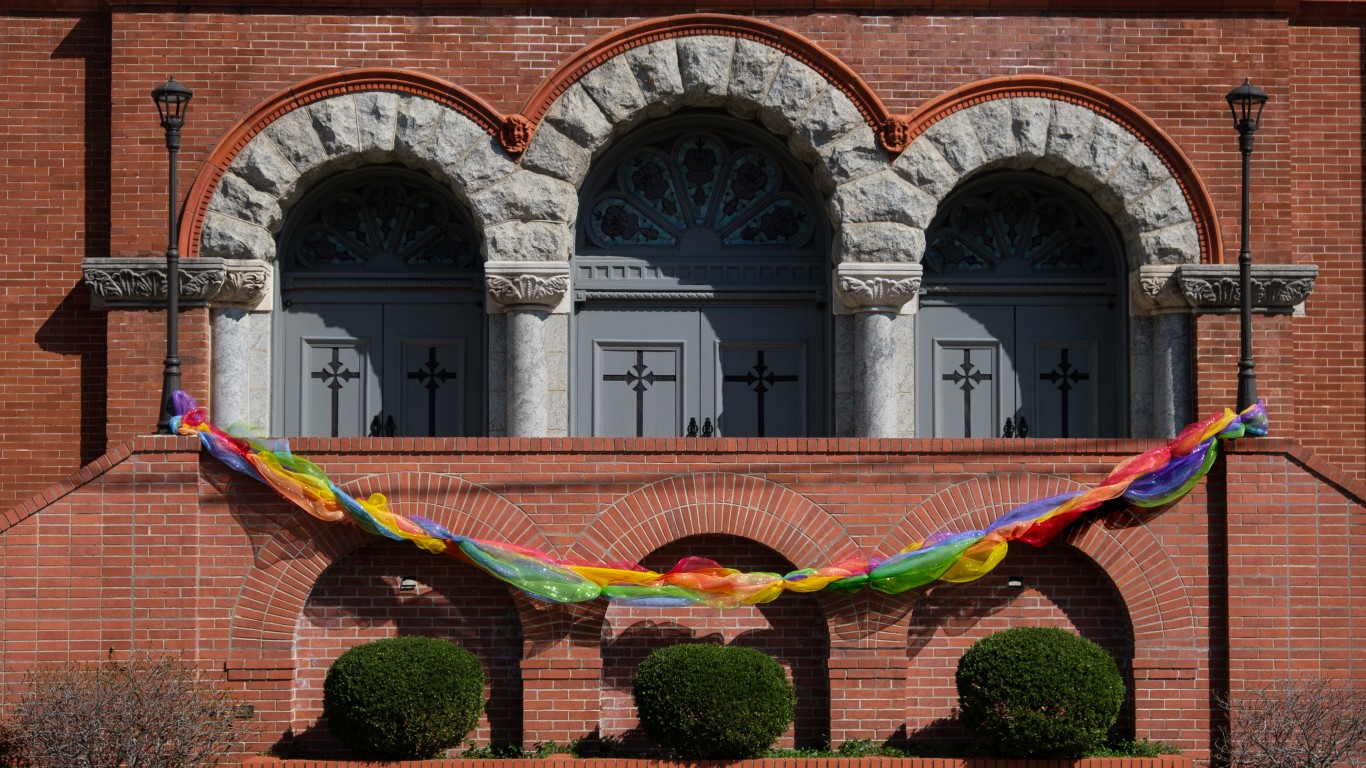
48. Arkansas
> LGBTQ equality score: -8 out of 43.5
> Sexual orientation policy score: -1.5 out of 20.5 (3rd lowest)
> Gender identity policy score: -6.5 out of 23 (4th lowest)
> Est. LGBTQ population (18+), July 2022: 78,000 (3.3% of 2,348,518)
> LGBTQ residents aged 25+ raising children: 36% (4th highest)
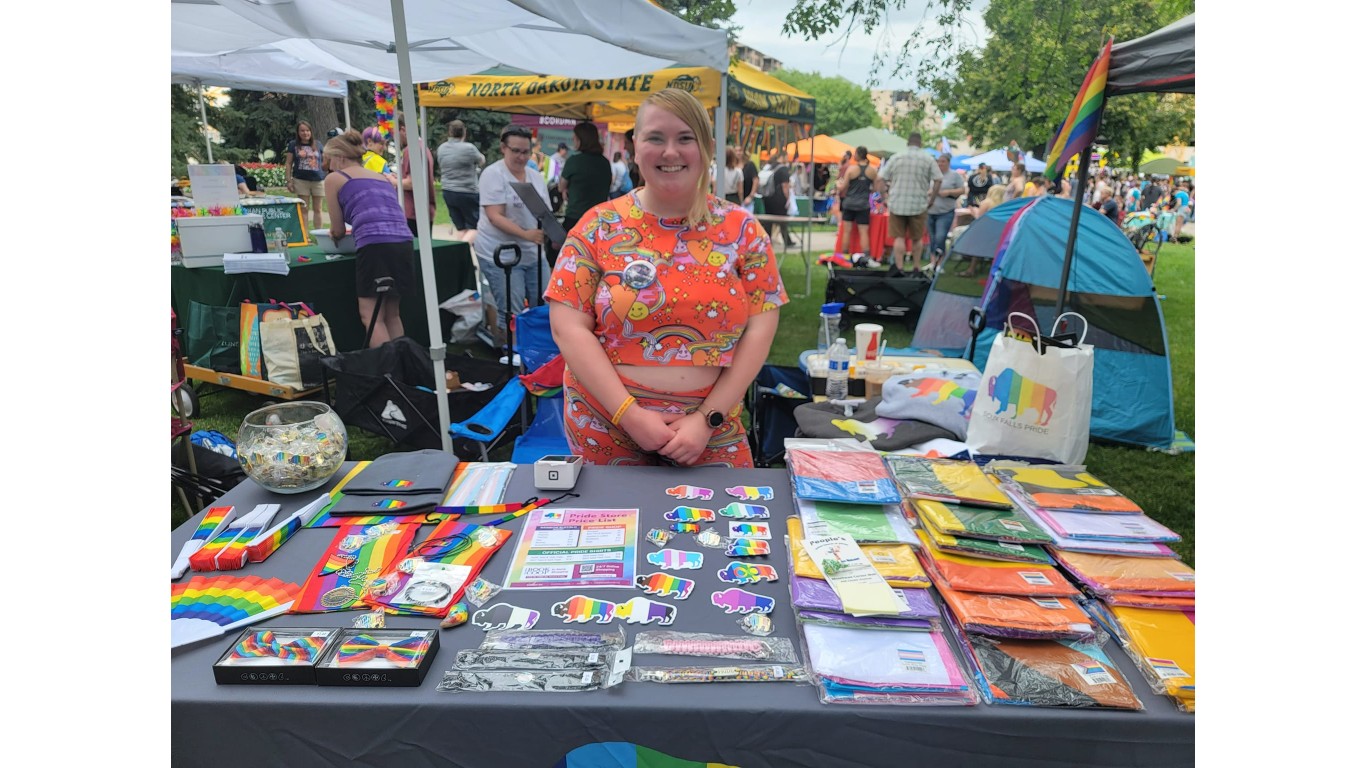
47. South Dakota
> LGBTQ equality score: -5.5 out of 43.5
> Sexual orientation policy score: -0.5 out of 20.5 (4th lowest)
> Gender identity policy score: -5 out of 23 (5th lowest)
> Est. LGBTQ population (18+), July 2022: 21,000 (3.0% of 690,659)
> LGBTQ residents aged 25+ raising children: 29% (16th highest – tied)
[in-text-ad-2]
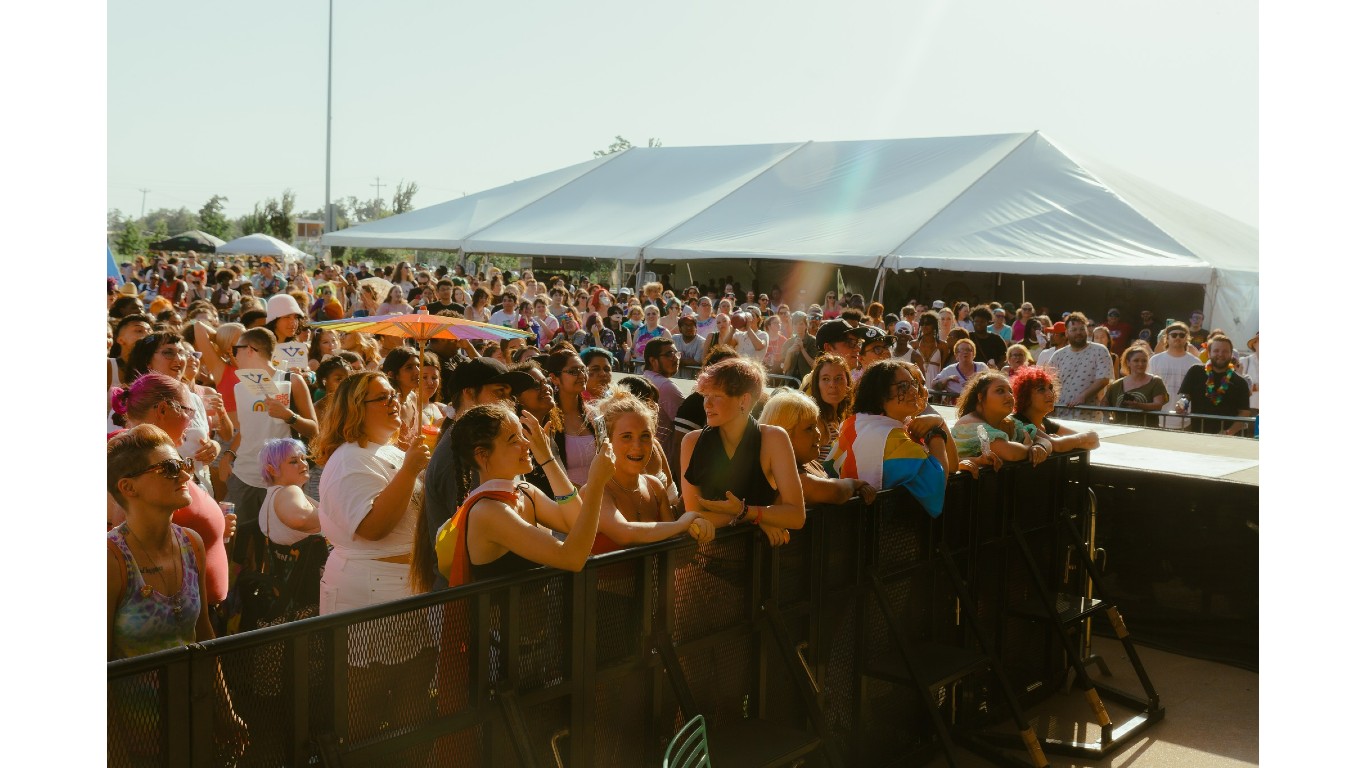
46. Oklahoma
> LGBTQ equality score: -5 out of 43.5
> Sexual orientation policy score: 2 out of 20.5 (9th lowest)
> Gender identity policy score: -7 out of 23 (3rd lowest)
> Est. LGBTQ population (18+), July 2022: 117,000 (3.8% of 3,066,654)
> LGBTQ residents aged 25+ raising children: 38% (3rd highest)
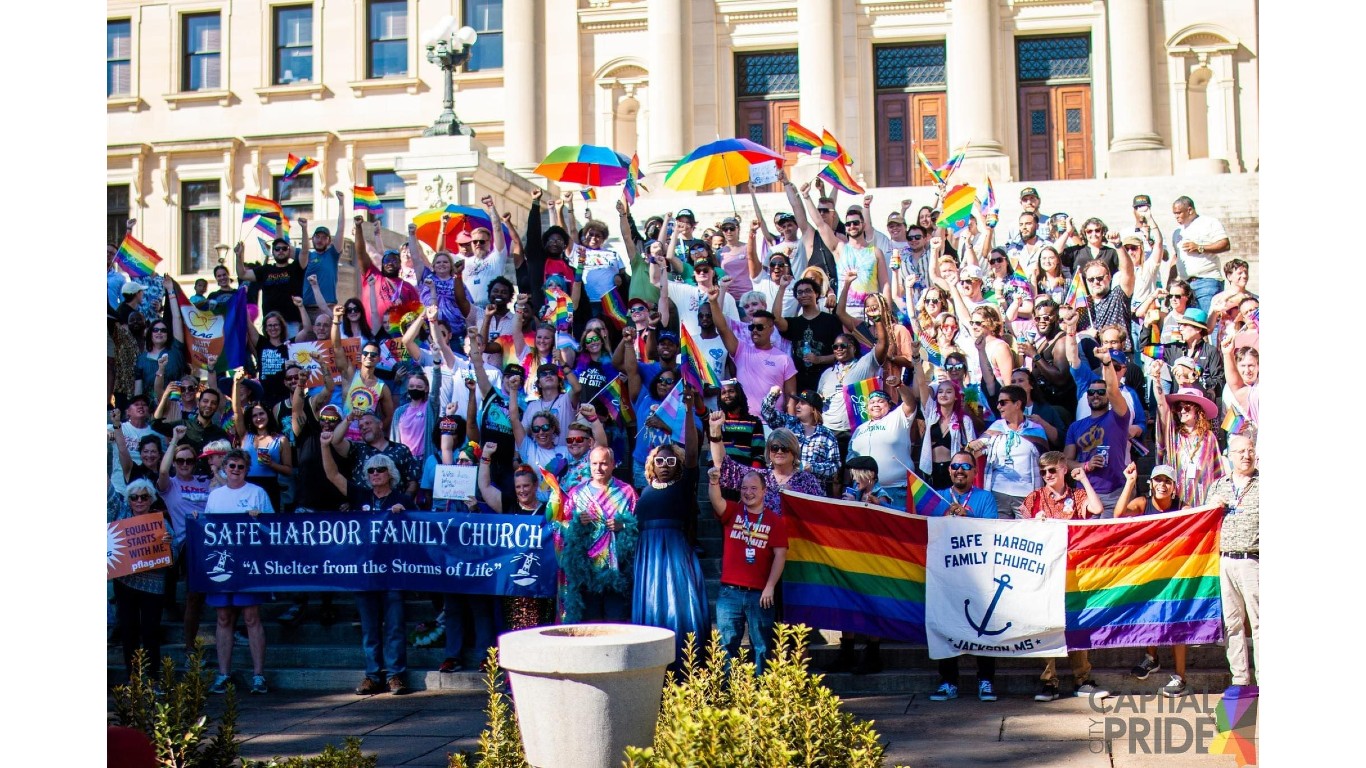
45. Mississippi
> LGBTQ equality score: -4 out of 43.5
> Sexual orientation policy score: 0 out of 20.5 (5th lowest)
> Gender identity policy score: -4 out of 23 (11th lowest)
> Est. LGBTQ population (18+), July 2022: 79,000 (3.5% of 2,261,996)
> LGBTQ residents aged 25+ raising children: 34% (6th highest – tied)
[in-text-ad]
44. Louisiana
> LGBTQ equality score: -3.5 out of 43.5
> Sexual orientation policy score: 1 out of 20.5 (6th lowest)
> Gender identity policy score: -4.5 out of 23 (10th lowest)
> Est. LGBTQ population (18+), July 2022: 138,000 (3.9% of 3,528,548)
> LGBTQ residents aged 25+ raising children: 28% (21st highest – tied)
43. South Carolina
> LGBTQ equality score: -2.5 out of 43.5
> Sexual orientation policy score: 2 out of 20.5 (9th lowest)
> Gender identity policy score: -4.5 out of 23 (10th lowest)
> Est. LGBTQ population (18+), July 2022: 146,000 (3.5% of 4,164,762)
> LGBTQ residents aged 25+ raising children: 30% (13th highest – tied)
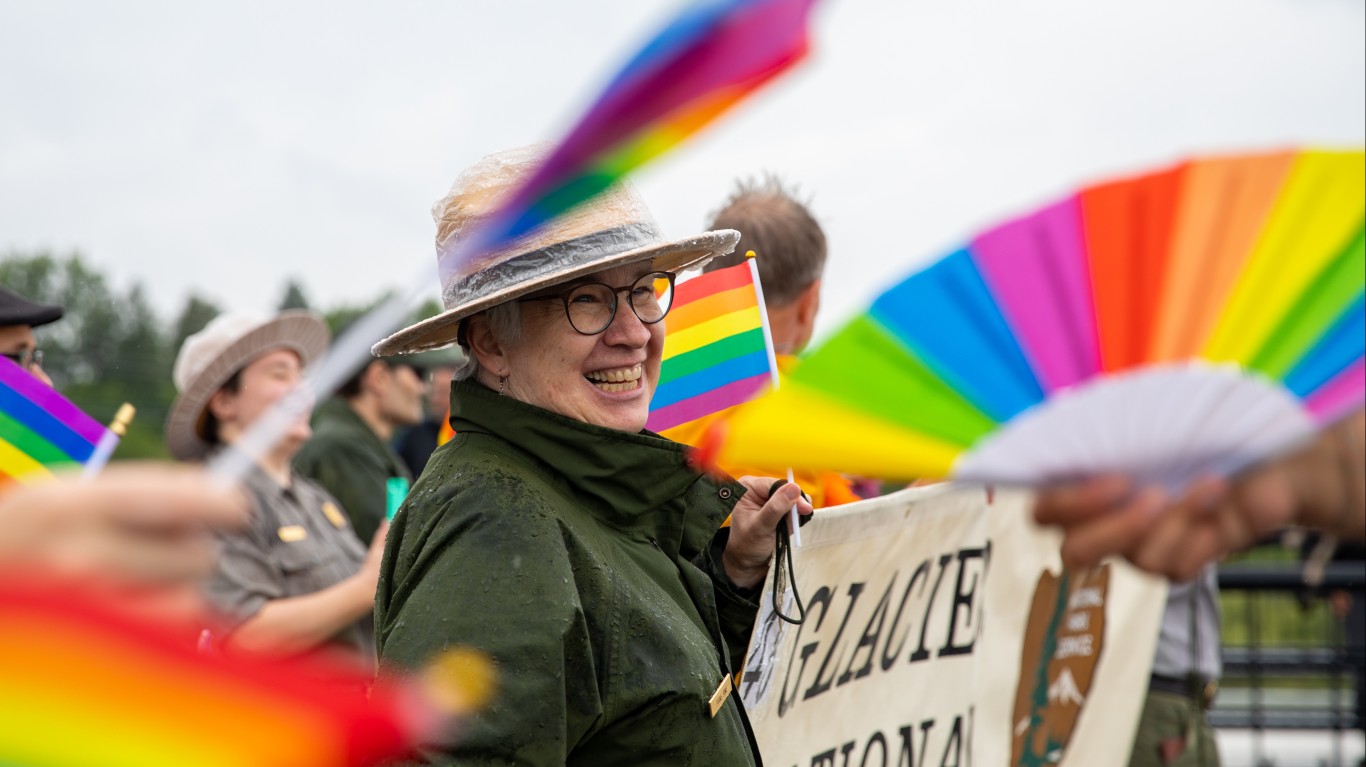
42. Montana
> LGBTQ equality score: -1.5 out of 43.5
> Sexual orientation policy score: 3 out of 20.5 (13th lowest)
> Gender identity policy score: -4.5 out of 23 (10th lowest)
> Est. LGBTQ population (18+), July 2022: 26,000 (2.9% of 889,114)
> LGBTQ residents aged 25+ raising children: 19% (3rd lowest – tied)
[in-text-ad-2]
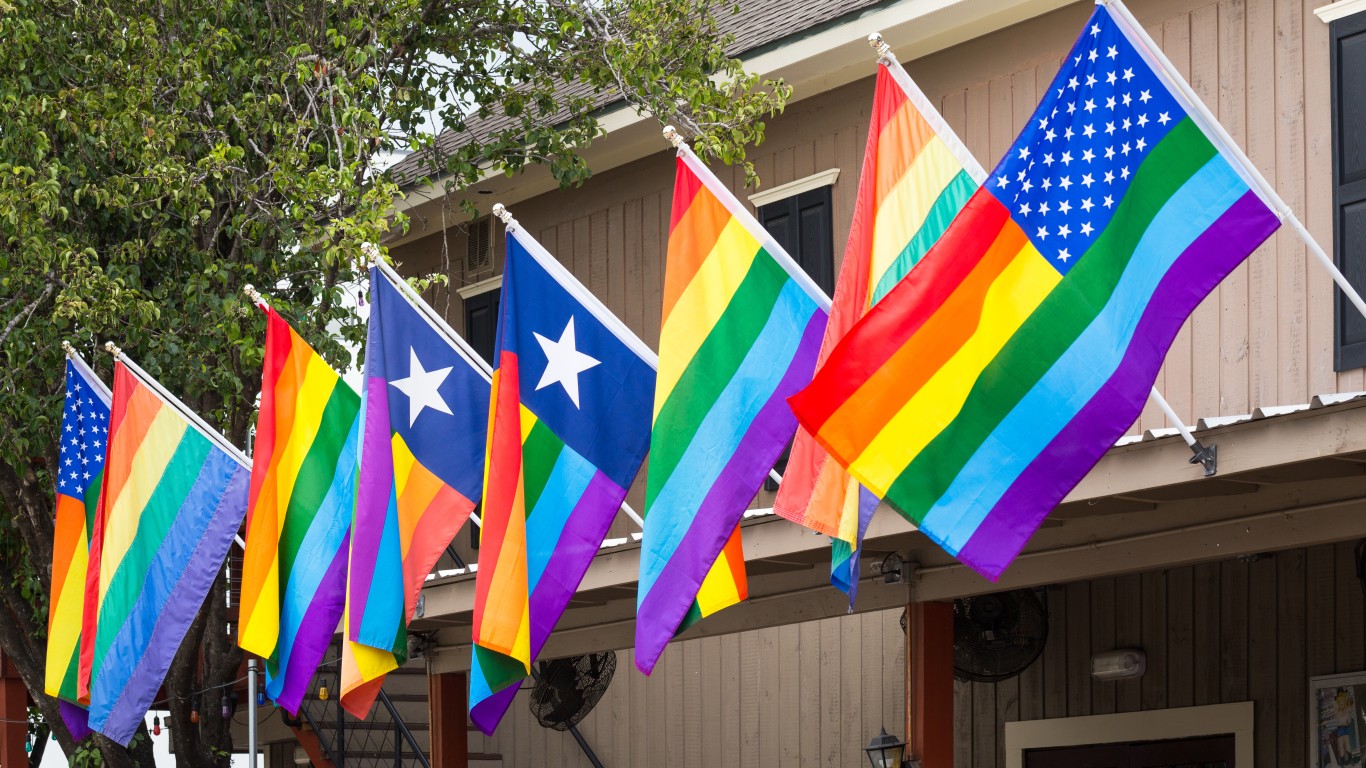
40. Texas
> LGBTQ equality score: -1 out of 43.5
> Sexual orientation policy score: 2.75 out of 20.5 (11th lowest)
> Gender identity policy score: -3.75 out of 23 (12th lowest)
> Est. LGBTQ population (18+), July 2022: 926,000 (4.1% of 22,573,234)
> LGBTQ residents aged 25+ raising children: 29% (16th highest – tied)

40. Indiana
> LGBTQ equality score: -1 out of 43.5
> Sexual orientation policy score: 3.75 out of 20.5 (14th lowest)
> Gender identity policy score: -4.75 out of 23 (7th lowest)
> Est. LGBTQ population (18+), July 2022: 237,000 (4.5% of 5,263,114)
> LGBTQ residents aged 25+ raising children: 34% (6th highest – tied)
[in-text-ad]
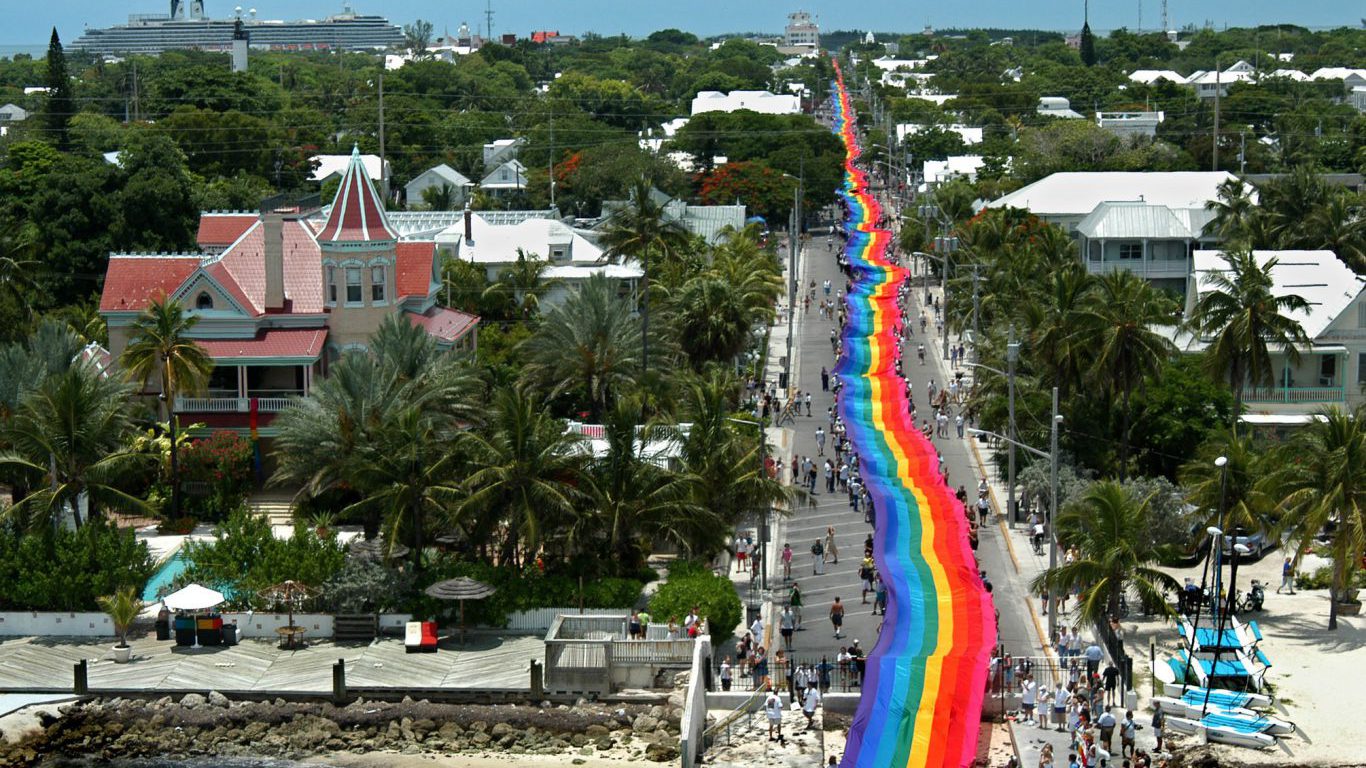
39. Florida
> LGBTQ equality score: -0.75 out of 43.5
> Sexual orientation policy score: 2.25 out of 20.5 (10th lowest)
> Gender identity policy score: -3 out of 23 (14th lowest)
> Est. LGBTQ population (18+), July 2022: 826,000 (4.6% of 17,948,469)
> LGBTQ residents aged 25+ raising children: 24% (14th lowest – tied)

38. Georgia
> LGBTQ equality score: -0.5 out of 43.5
> Sexual orientation policy score: 2 out of 20.5 (9th lowest)
> Gender identity policy score: -2.5 out of 23 (15th lowest)
> Est. LGBTQ population (18+), July 2022: 378,000 (4.5% of 8,402,753)
> LGBTQ residents aged 25+ raising children: 27% (25th lowest – tied)

37. Missouri
> LGBTQ equality score: -0.25 out of 43.5
> Sexual orientation policy score: 4.5 out of 20.5 (17th lowest)
> Gender identity policy score: -4.75 out of 23 (7th lowest)
> Est. LGBTQ population (18+), July 2022: 183,000 (3.8% of 4,813,049)
> LGBTQ residents aged 25+ raising children: 26% (21st lowest – tied)
[in-text-ad-2]

36. Wyoming
> LGBTQ equality score: 2.25 out of 43.5
> Sexual orientation policy score: 3 out of 20.5 (13th lowest)
> Gender identity policy score: -0.75 out of 23 (19th lowest)
> Est. LGBTQ population (18+), July 2022: 15,000 (3.3% of 451,267)
> LGBTQ residents aged 25+ raising children: 28% (21st highest – tied)

35. Nebraska
> LGBTQ equality score: 3 out of 43.5
> Sexual orientation policy score: 5.25 out of 20.5 (20th lowest)
> Gender identity policy score: -2.25 out of 23 (16th lowest)
> Est. LGBTQ population (18+), July 2022: 57,000 (3.8% of 1,491,246)
> LGBTQ residents aged 25+ raising children: 32% (10th highest)
[in-text-ad]

33. Arizona
> LGBTQ equality score: 3.25 out of 43.5
> Sexual orientation policy score: 6.25 out of 20.5 (21st lowest)
> Gender identity policy score: -3 out of 23 (14th lowest)
> Est. LGBTQ population (18+), July 2022: 260,000 (4.5% of 5,770,187)
> LGBTQ residents aged 25+ raising children: 25% (17th lowest – tied)

33. Idaho
> LGBTQ equality score: 3.25 out of 43.5
> Sexual orientation policy score: 4.25 out of 20.5 (16th lowest)
> Gender identity policy score: -1 out of 23 (18th lowest)
> Est. LGBTQ population (18+), July 2022: 41,000 (2.8% of 1,475,629)
> LGBTQ residents aged 25+ raising children: 44% (the highest)
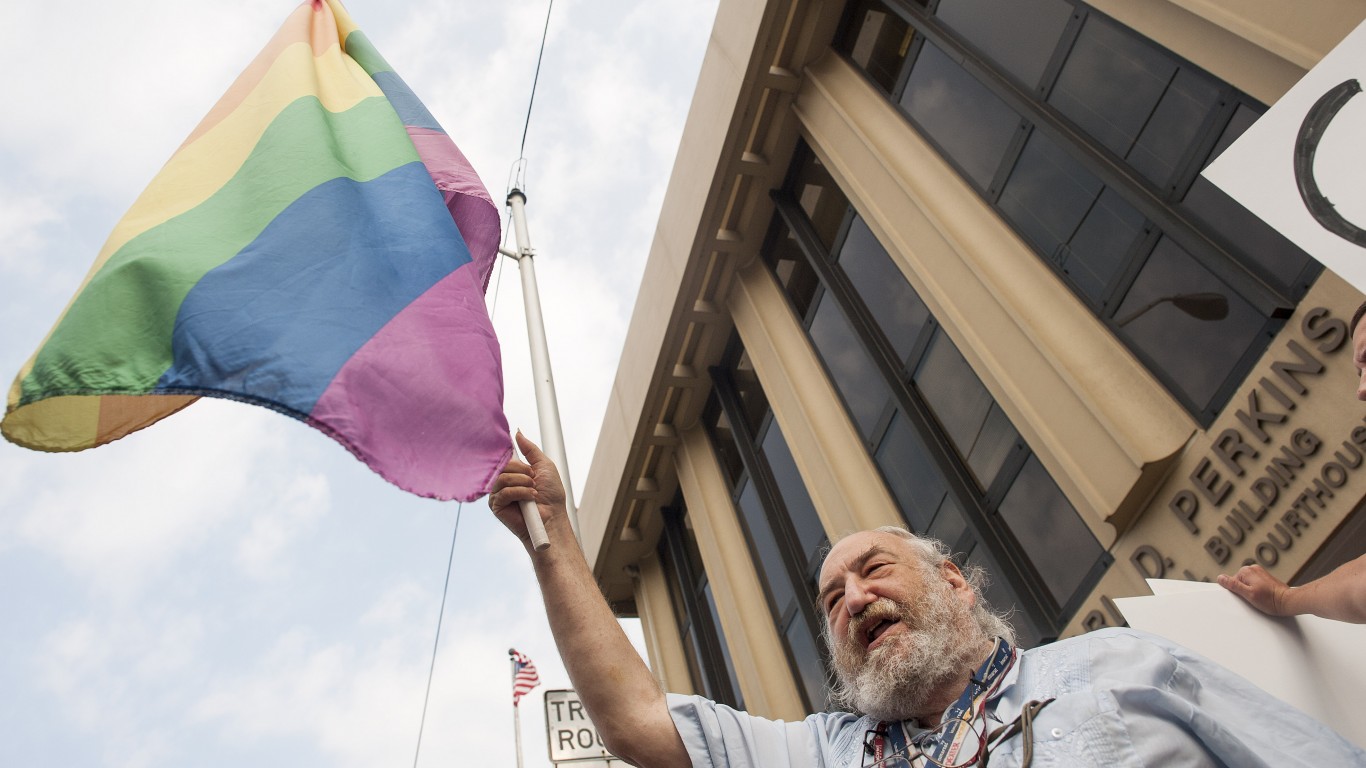
32. Kentucky
> LGBTQ equality score: 5.25 out of 43.5
> Sexual orientation policy score: 6.75 out of 20.5 (25th highest)
> Gender identity policy score: -1.5 out of 23 (17th lowest)
> Est. LGBTQ population (18+), July 2022: 119,000 (3.4% of 3,507,735)
> LGBTQ residents aged 25+ raising children: 26% (21st lowest – tied)
[in-text-ad-2]
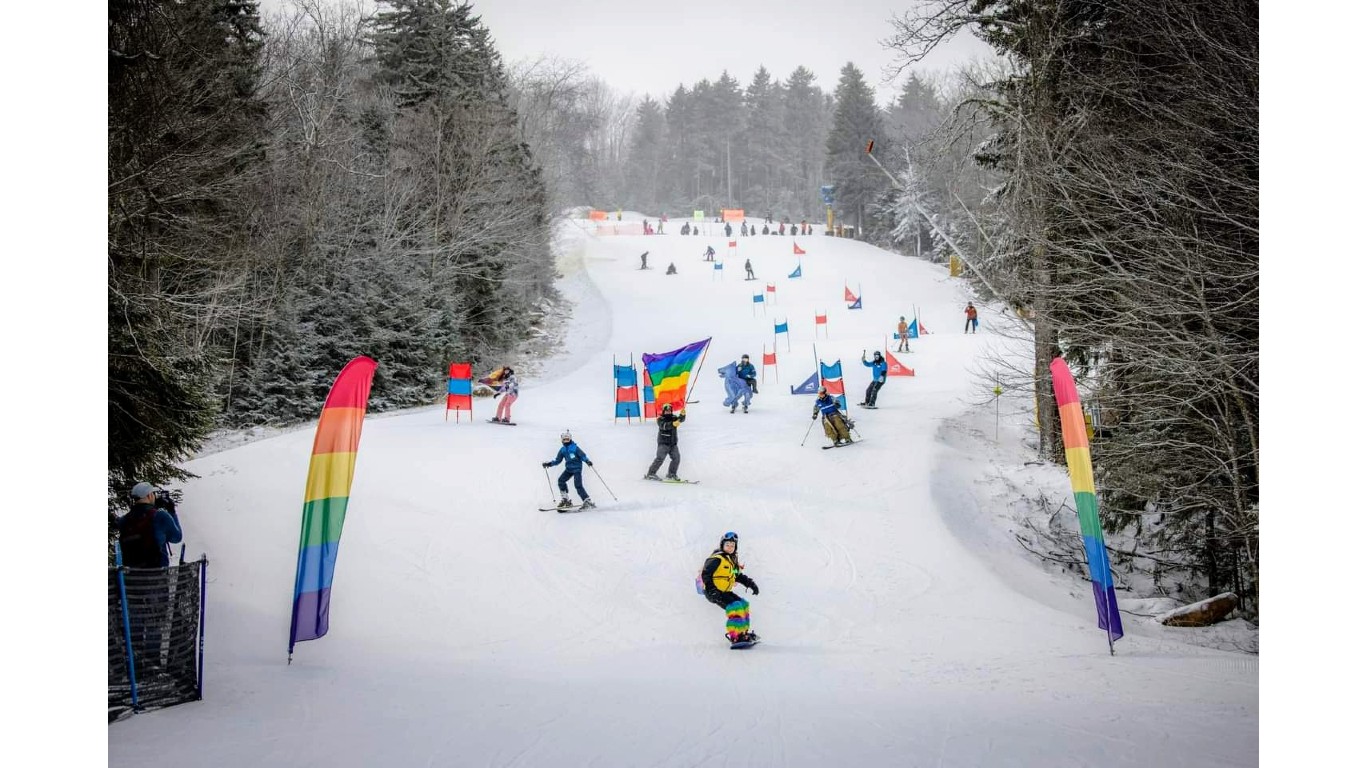
31. West Virginia
> LGBTQ equality score: 5.5 out of 43.5
> Sexual orientation policy score: 5 out of 20.5 (18th lowest)
> Gender identity policy score: 0.5 out of 23 (21st lowest)
> Est. LGBTQ population (18+), July 2022: 57,000 (4.0% of 1,423,234)
> LGBTQ residents aged 25+ raising children: 31% (11th highest – tied)
30. Kansas
> LGBTQ equality score: 5.75 out of 43.5
> Sexual orientation policy score: 4.25 out of 20.5 (16th lowest)
> Gender identity policy score: 1.5 out of 23 (22nd lowest)
> Est. LGBTQ population (18+), July 2022: 74,000 (3.3% of 2,246,318)
> LGBTQ residents aged 25+ raising children: 33% (9th highest)
[in-text-ad]

29. North Dakota
> LGBTQ equality score: 8.25 out of 43.5
> Sexual orientation policy score: 8.5 out of 20.5 (24th highest)
> Gender identity policy score: -0.25 out of 23 (20th lowest)
> Est. LGBTQ population (18+), July 2022: 16,000 (2.7% of 596,486)
> LGBTQ residents aged 25+ raising children: 10% (the lowest)
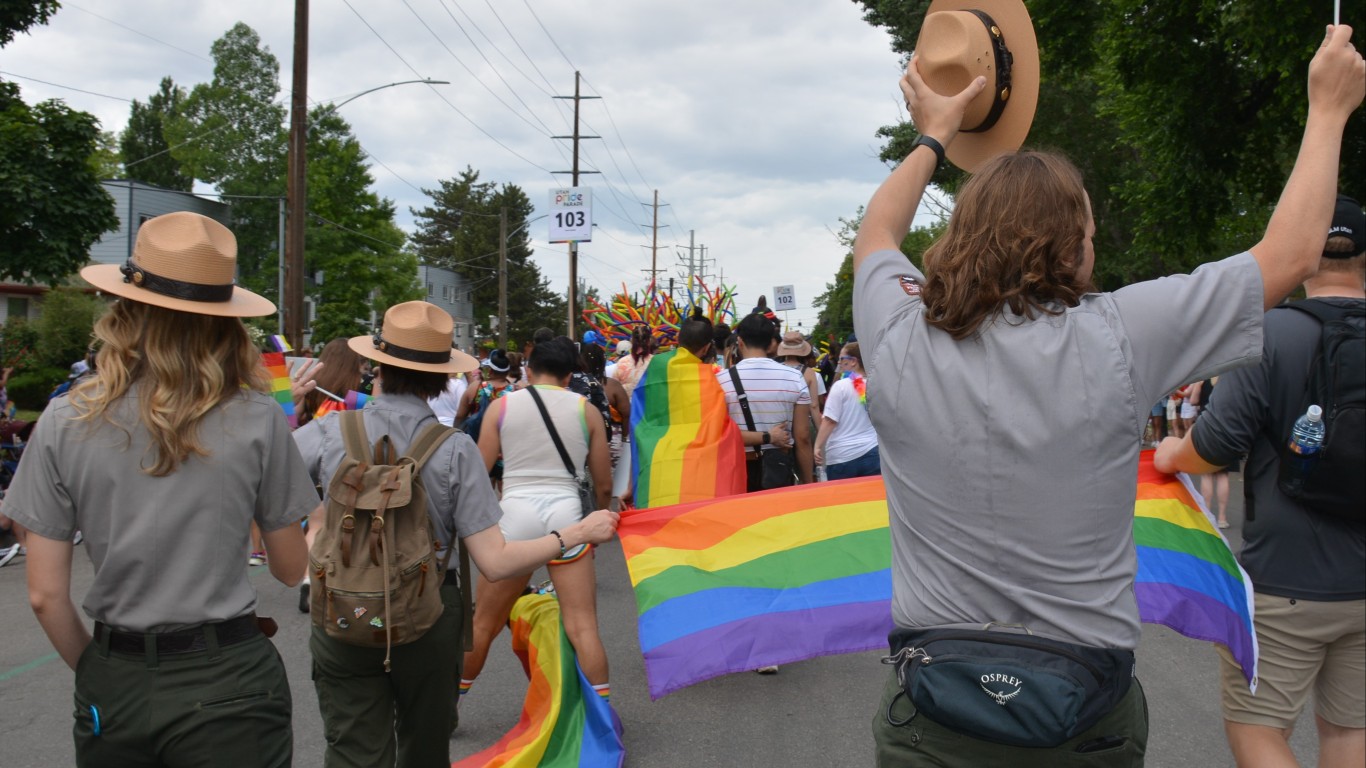
28. Utah
> LGBTQ equality score: 9.25 out of 43.5
> Sexual orientation policy score: 6.5 out of 20.5 (23rd lowest)
> Gender identity policy score: 2.75 out of 23 (24th lowest)
> Est. LGBTQ population (18+), July 2022: 91,000 (3.7% of 2,449,192)
> LGBTQ residents aged 25+ raising children: 40% (2nd highest)
27. Alaska
> LGBTQ equality score: 10.25 out of 43.5
> Sexual orientation policy score: 5.25 out of 20.5 (20th lowest)
> Gender identity policy score: 5 out of 23 (25th highest)
> Est. LGBTQ population (18+), July 2022: 21,000 (3.7% of 557,060)
> LGBTQ residents aged 25+ raising children: 34% (6th highest – tied)
[in-text-ad-2]
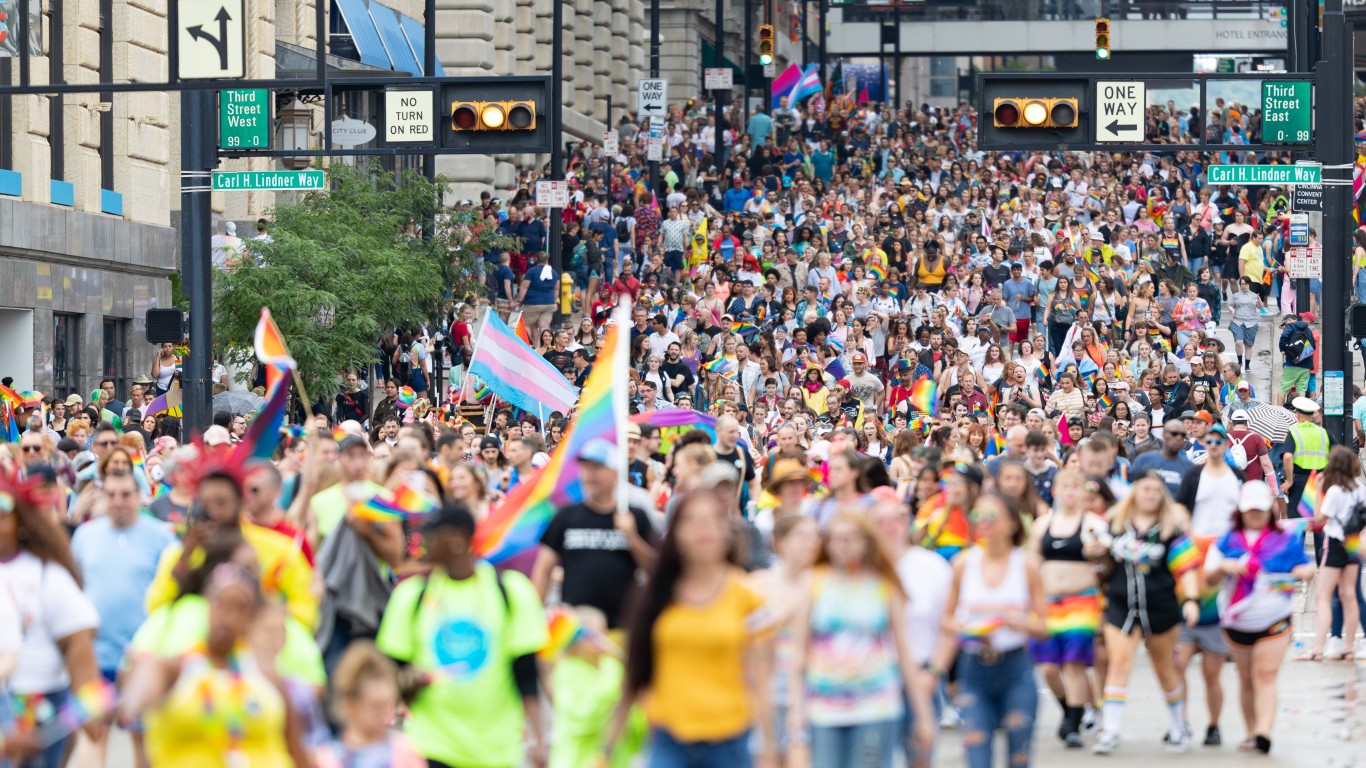
26. Ohio
> LGBTQ equality score: 10.75 out of 43.5
> Sexual orientation policy score: 6.5 out of 20.5 (23rd lowest)
> Gender identity policy score: 4.25 out of 23 (25th lowest)
> Est. LGBTQ population (18+), July 2022: 395,000 (4.3% of 9,193,508)
> LGBTQ residents aged 25+ raising children: 30% (13th highest – tied)
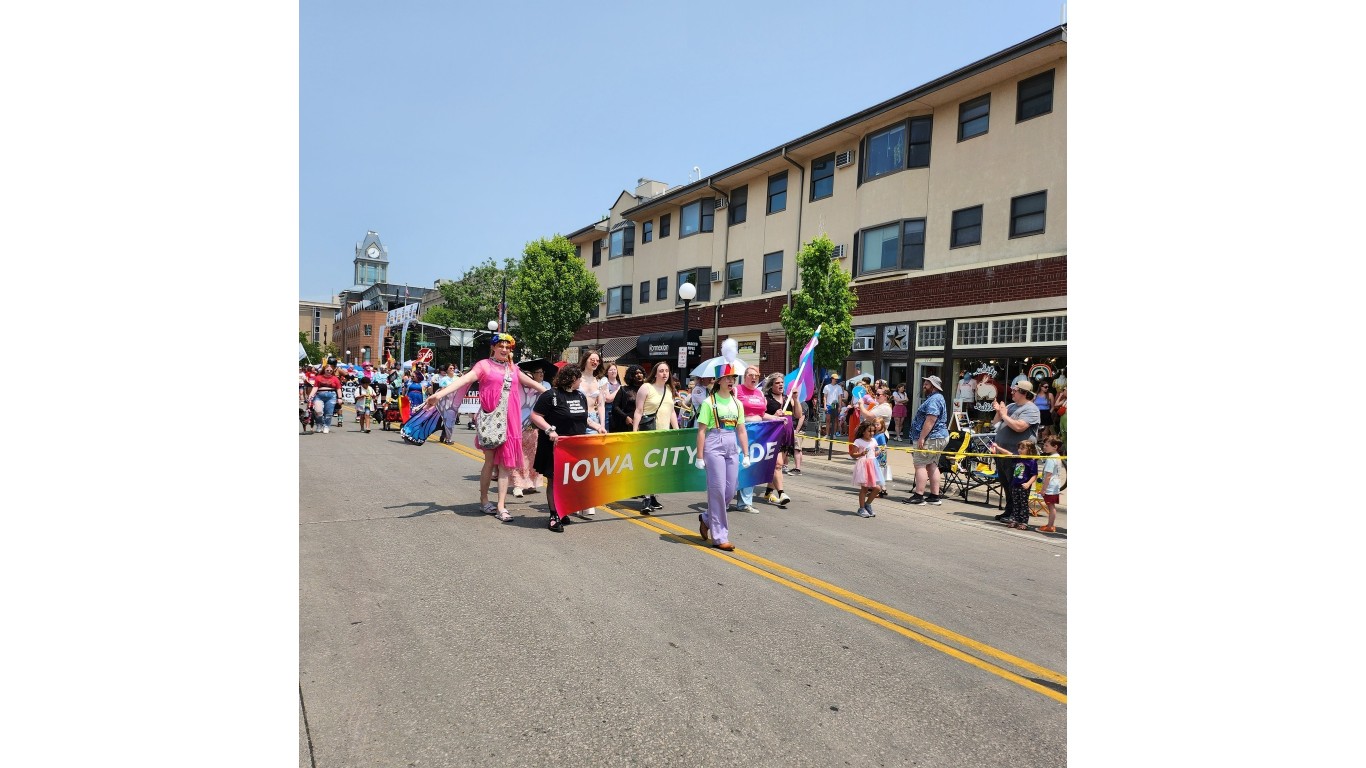
25. Iowa
> LGBTQ equality score: 12.5 out of 43.5
> Sexual orientation policy score: 10 out of 20.5 (22nd highest)
> Gender identity policy score: 2.5 out of 23 (23rd lowest)
> Est. LGBTQ population (18+), July 2022: 89,000 (3.6% of 2,476,028)
> LGBTQ residents aged 25+ raising children: 27% (25th lowest – tied)
[in-text-ad]
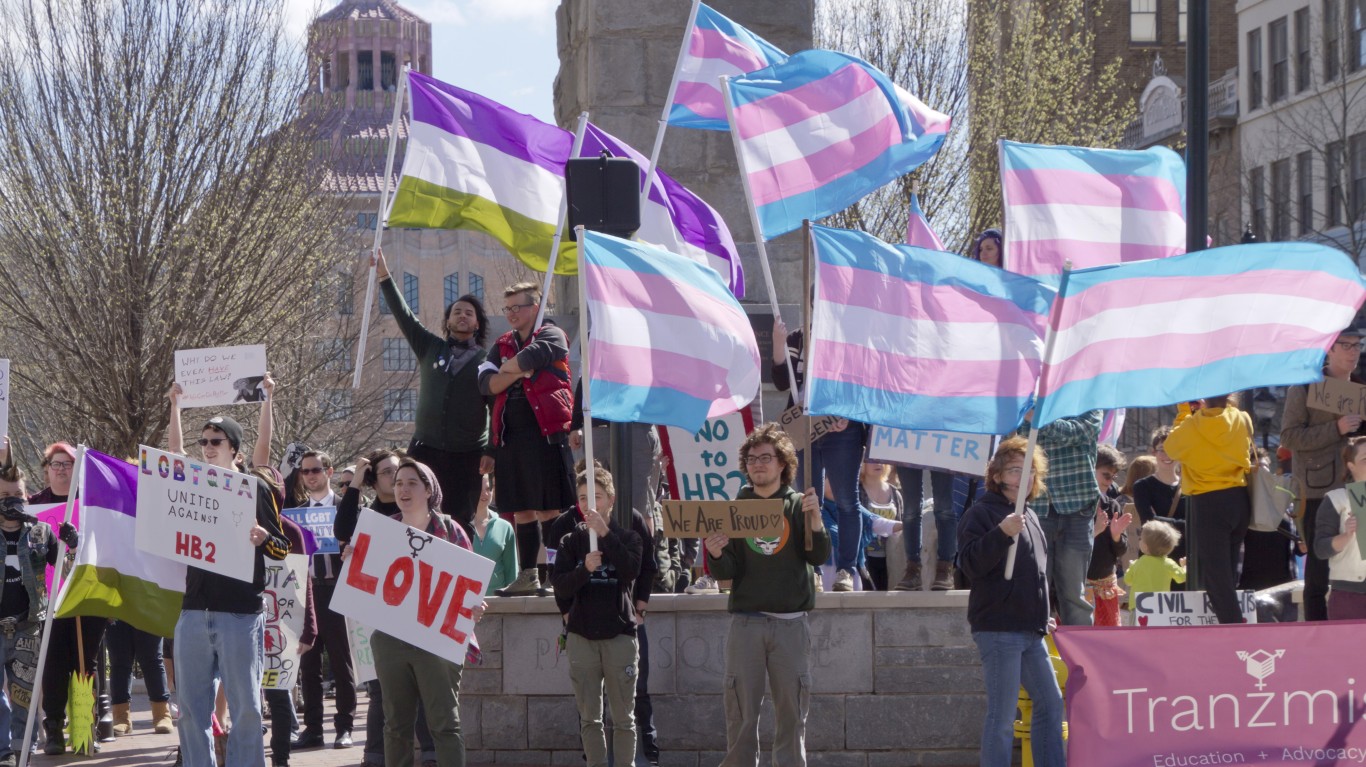
24. North Carolina
> LGBTQ equality score: 12.75 out of 43.5
> Sexual orientation policy score: 6.75 out of 20.5 (25th highest)
> Gender identity policy score: 6 out of 23 (23rd highest)
> Est. LGBTQ population (18+), July 2022: 336,000 (4.0% of 8,404,094)
> LGBTQ residents aged 25+ raising children: 26% (21st lowest – tied)
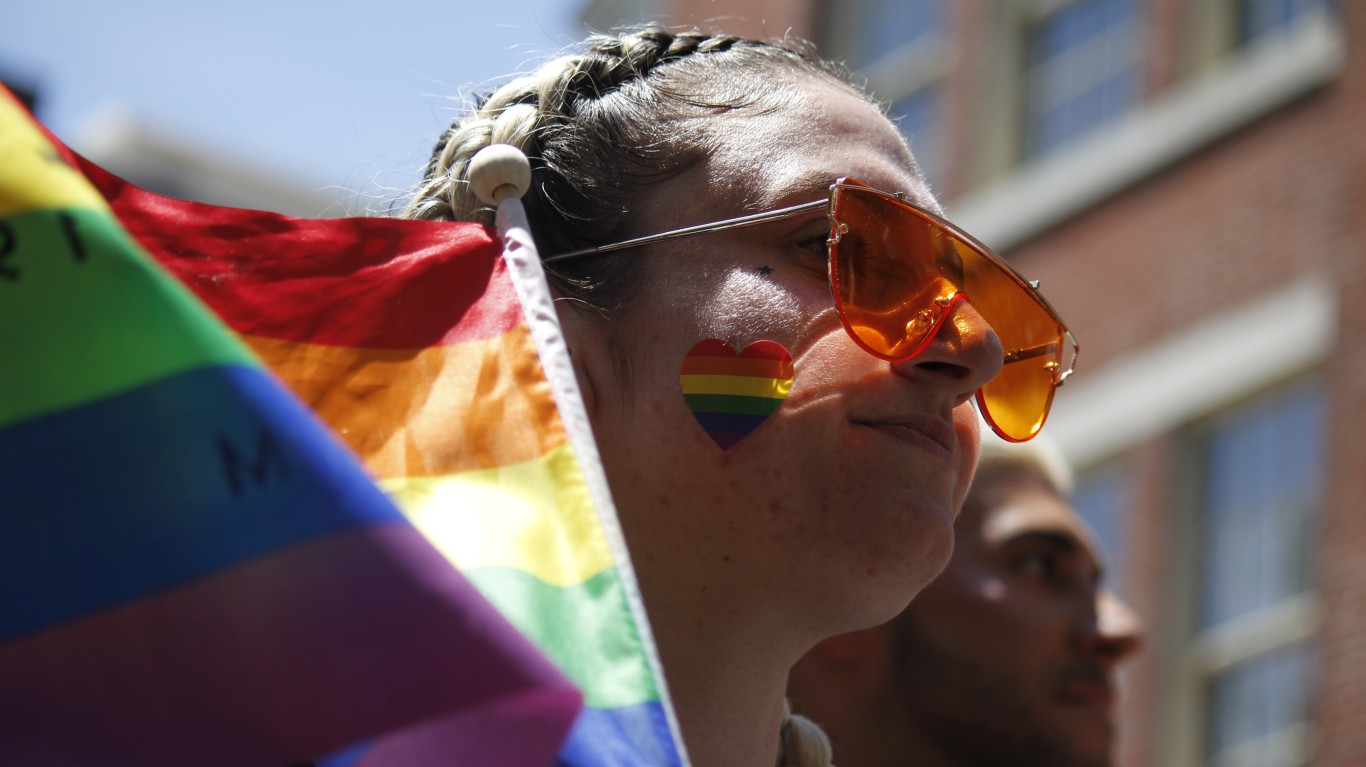
23. Pennsylvania
> LGBTQ equality score: 16.5 out of 43.5
> Sexual orientation policy score: 6.75 out of 20.5 (25th highest)
> Gender identity policy score: 9.75 out of 23 (22nd highest)
> Est. LGBTQ population (18+), July 2022: 424,000 (4.1% of 10,347,543)
> LGBTQ residents aged 25+ raising children: 27% (25th lowest – tied)

22. Wisconsin
> LGBTQ equality score: 18.5 out of 43.5
> Sexual orientation policy score: 13.25 out of 20.5 (20th highest)
> Gender identity policy score: 5.25 out of 23 (24th highest)
> Est. LGBTQ population (18+), July 2022: 177,000 (3.8% of 4,646,910)
> LGBTQ residents aged 25+ raising children: 29% (16th highest – tied)
[in-text-ad-2]

21. Michigan
> LGBTQ equality score: 21.5 out of 43.5
> Sexual orientation policy score: 8.75 out of 20.5 (23rd highest)
> Gender identity policy score: 12.75 out of 23 (21st highest)
> Est. LGBTQ population (18+), July 2022: 317,000 (4.0% of 7,924,418)
> LGBTQ residents aged 25+ raising children: 27% (25th lowest – tied)
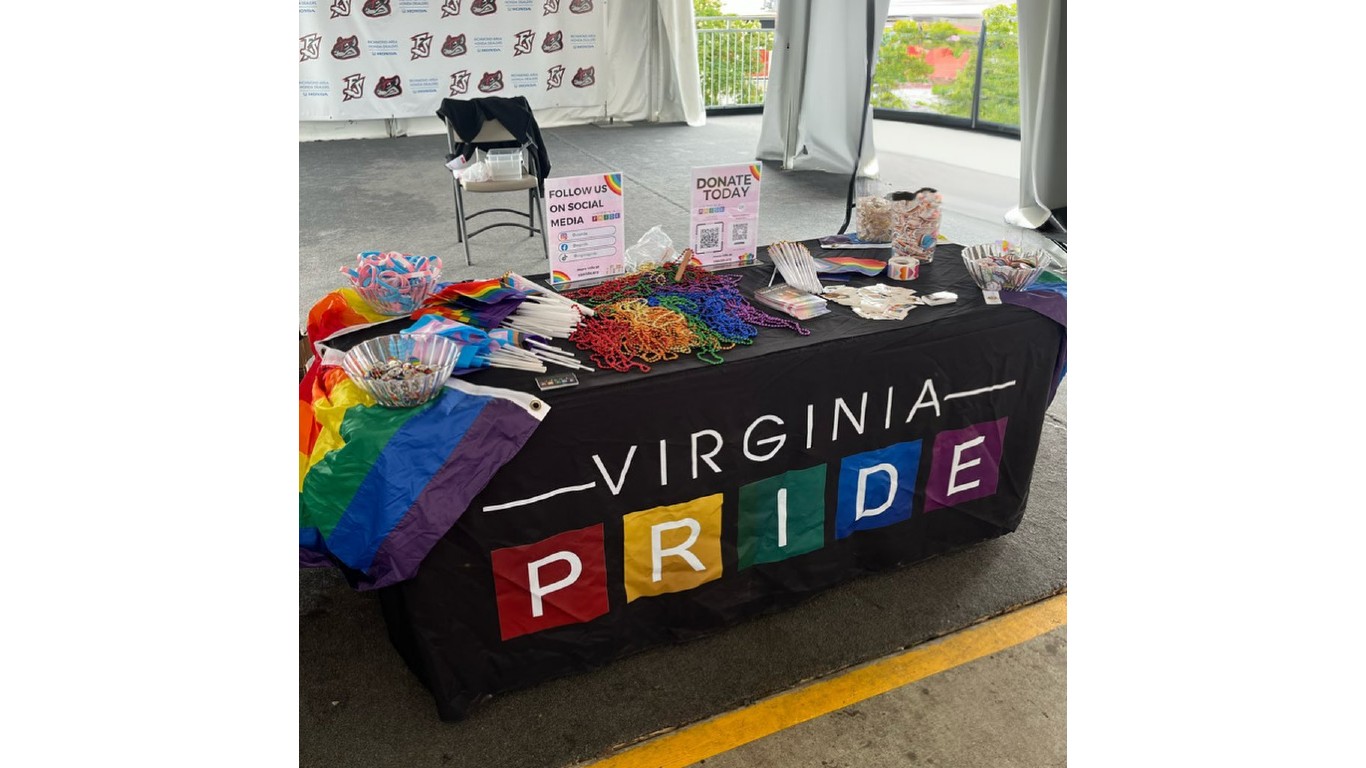
20. Virginia
> LGBTQ equality score: 25.5 out of 43.5
> Sexual orientation policy score: 11 out of 20.5 (21st highest)
> Gender identity policy score: 14.5 out of 23 (19th highest)
> Est. LGBTQ population (18+), July 2022: 266,000 (3.9% of 6,816,709)
> LGBTQ residents aged 25+ raising children: 26% (21st lowest – tied)
[in-text-ad]

19. Delaware
> LGBTQ equality score: 29 out of 43.5
> Sexual orientation policy score: 13.75 out of 20.5 (18th highest)
> Gender identity policy score: 15.25 out of 23 (18th highest)
> Est. LGBTQ population (18+), July 2022: 36,000 (4.5% of 810,269)
> LGBTQ residents aged 25+ raising children: 35% (5th highest)
18. New Hampshire
> LGBTQ equality score: 29.5 out of 43.5
> Sexual orientation policy score: 15 out of 20.5 (16th highest)
> Gender identity policy score: 14.5 out of 23 (19th highest)
> Est. LGBTQ population (18+), July 2022: 54,000 (4.7% of 1,142,307)
> LGBTQ residents aged 25+ raising children: 31% (11th highest – tied)
17. Maryland
> LGBTQ equality score: 31.5 out of 43.5
> Sexual orientation policy score: 13.75 out of 20.5 (18th highest)
> Gender identity policy score: 17.75 out of 23 (15th highest)
> Est. LGBTQ population (18+), July 2022: 202,000 (4.2% of 4,818,071)
> LGBTQ residents aged 25+ raising children: 20% (5th lowest – tied)
[in-text-ad-2]
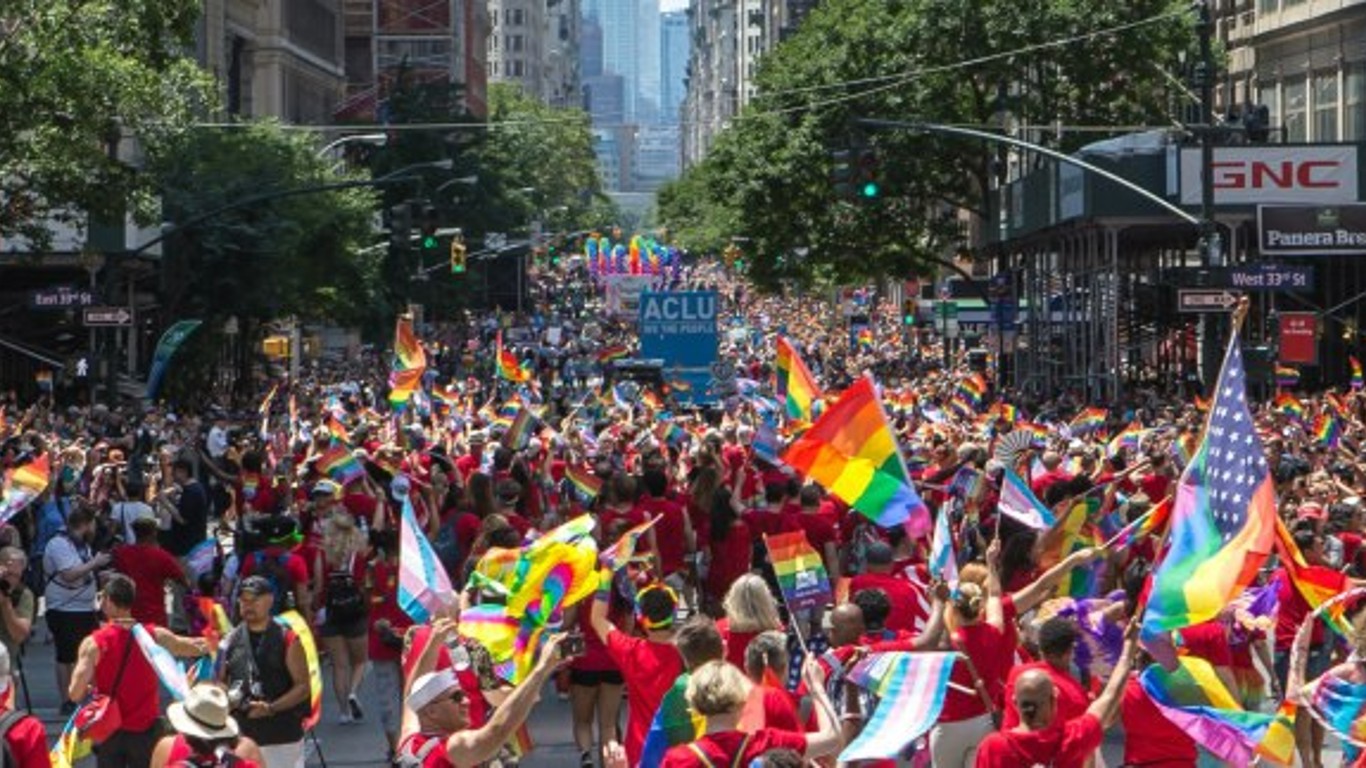
16. New Mexico
> LGBTQ equality score: 32 out of 43.5
> Sexual orientation policy score: 14 out of 20.5 (17th highest)
> Gender identity policy score: 18 out of 23 (14th highest)
> Est. LGBTQ population (18+), July 2022: 74,000 (4.5% of 1,653,831)
> LGBTQ residents aged 25+ raising children: 29% (16th highest – tied)

15. Rhode Island
> LGBTQ equality score: 33 out of 43.5
> Sexual orientation policy score: 16 out of 20.5 (13th highest)
> Gender identity policy score: 17 out of 23 (17th highest)
> Est. LGBTQ population (18+), July 2022: 40,000 (4.5% of 889,822)
> LGBTQ residents aged 25+ raising children: 19% (3rd lowest – tied)
[in-text-ad]
14. Hawaii
> LGBTQ equality score: 33.5 out of 43.5
> Sexual orientation policy score: 16 out of 20.5 (13th highest)
> Gender identity policy score: 17.5 out of 23 (16th highest)
> Est. LGBTQ population (18+), July 2022: 53,000 (4.6% of 1,142,870)
> LGBTQ residents aged 25+ raising children: 30% (13th highest – tied)

13. Minnesota
> LGBTQ equality score: 35.5 out of 43.5
> Sexual orientation policy score: 15.5 out of 20.5 (15th highest)
> Gender identity policy score: 20 out of 23 (10th highest)
> Est. LGBTQ population (18+), July 2022: 181,000 (4.1% of 4,423,022)
> LGBTQ residents aged 25+ raising children: 28% (21st highest – tied)
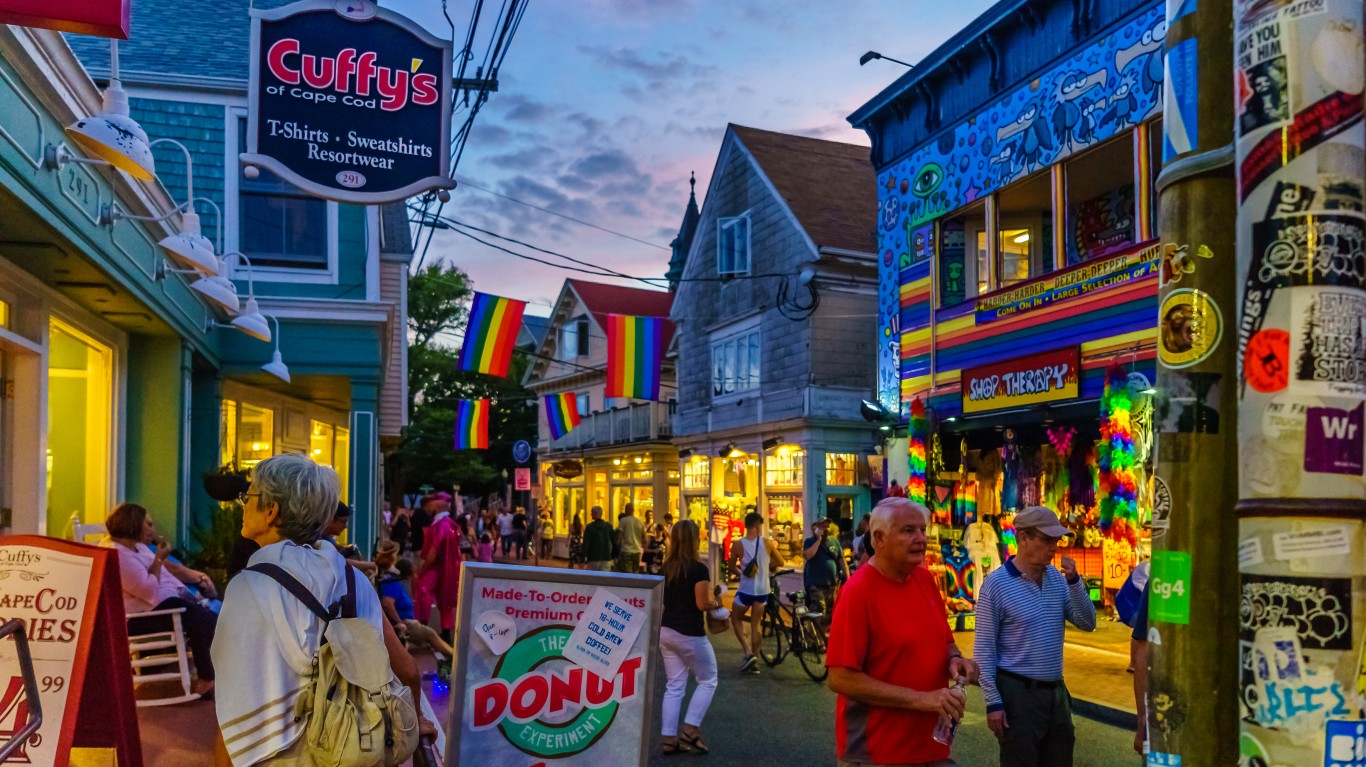
12. Massachusetts
> LGBTQ equality score: 36 out of 43.5
> Sexual orientation policy score: 17.5 out of 20.5 (9th highest)
> Gender identity policy score: 18.5 out of 23 (13th highest)
> Est. LGBTQ population (18+), July 2022: 305,000 (5.4% of 5,644,540)
> LGBTQ residents aged 25+ raising children: 21% (7th lowest – tied)
[in-text-ad-2]
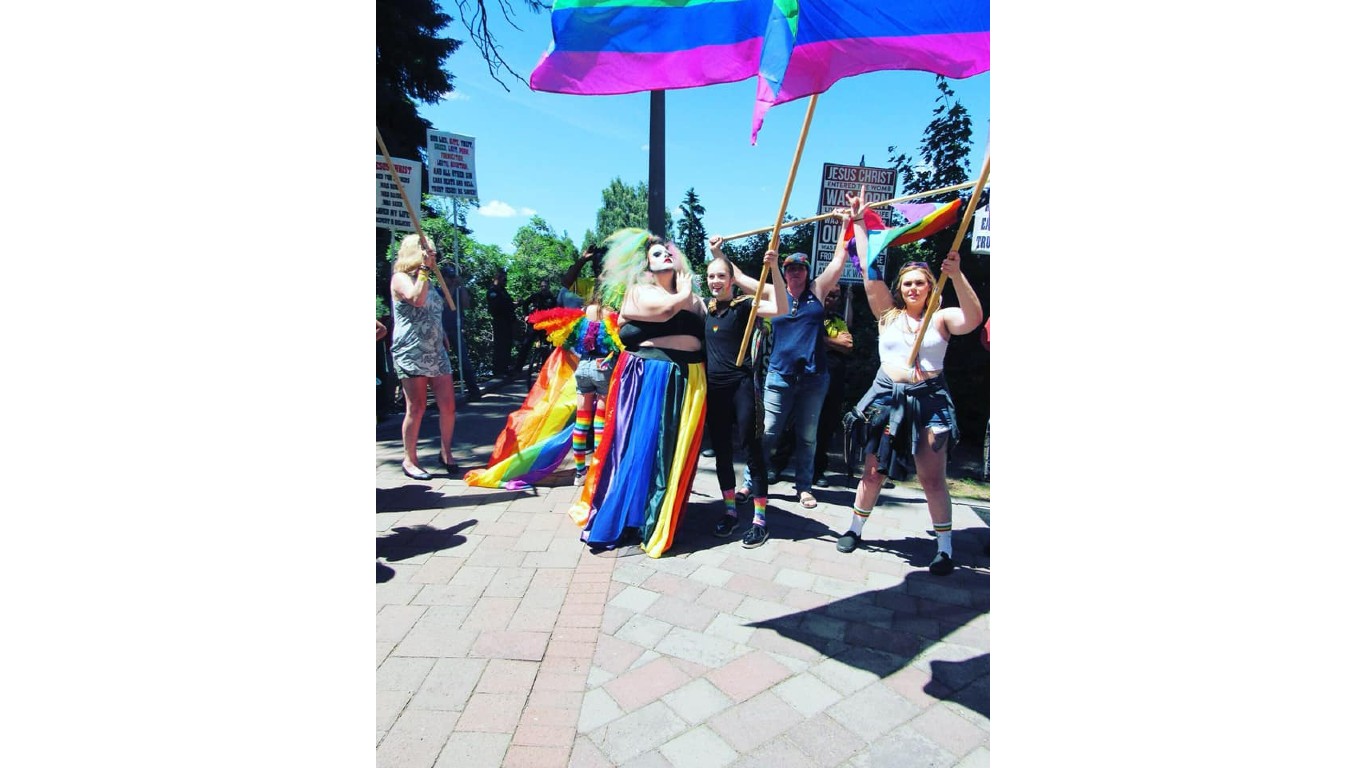
10. Oregon
> LGBTQ equality score: 37.5 out of 43.5
> Sexual orientation policy score: 17.5 out of 20.5 (9th highest)
> Gender identity policy score: 20 out of 23 (10th highest)
> Est. LGBTQ population (18+), July 2022: 191,000 (5.6% of 3,403,149)
> LGBTQ residents aged 25+ raising children: 23% (11th lowest – tied)

10. Illinois
> LGBTQ equality score: 37.5 out of 43.5
> Sexual orientation policy score: 18 out of 20.5 (6th highest)
> Gender identity policy score: 19.5 out of 23 (12th highest)
> Est. LGBTQ population (18+), July 2022: 424,000 (4.3% of 9,861,901)
> LGBTQ residents aged 25+ raising children: 28% (21st highest – tied)
[in-text-ad]
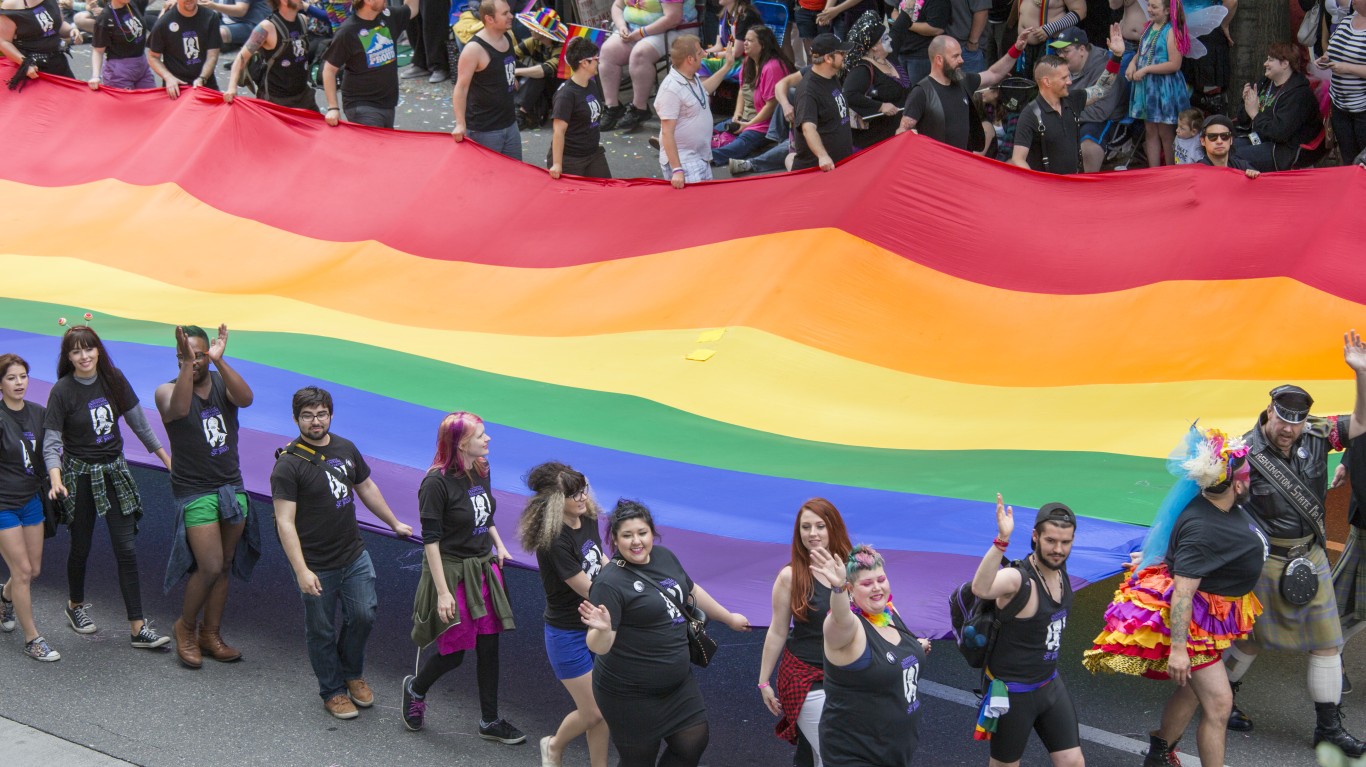
9. Washington
> LGBTQ equality score: 38.25 out of 43.5
> Sexual orientation policy score: 17.25 out of 20.5 (12th highest)
> Gender identity policy score: 21 out of 23 (4th highest)
> Est. LGBTQ population (18+), July 2022: 319,000 (5.2% of 6,139,213)
> LGBTQ residents aged 25+ raising children: 28% (21st highest – tied)
8. Vermont
> LGBTQ equality score: 38.5 out of 43.5
> Sexual orientation policy score: 18 out of 20.5 (6th highest)
> Gender identity policy score: 20.5 out of 23 (7th highest)
> Est. LGBTQ population (18+), July 2022: 28,000 (5.2% of 532,307)
> LGBTQ residents aged 25+ raising children: 23% (11th lowest – tied)

7. Connecticut
> LGBTQ equality score: 39 out of 43.5
> Sexual orientation policy score: 18 out of 20.5 (6th highest)
> Gender identity policy score: 21 out of 23 (4th highest)
> Est. LGBTQ population (18+), July 2022: 113,000 (3.9% of 2,895,175)
> LGBTQ residents aged 25+ raising children: 20% (5th lowest – tied)
[in-text-ad-2]
6. New Jersey
> LGBTQ equality score: 39.25 out of 43.5
> Sexual orientation policy score: 17.5 out of 20.5 (9th highest)
> Gender identity policy score: 21.75 out of 23 (3rd highest)
> Est. LGBTQ population (18+), July 2022: 298,000 (4.1% of 7,267,590)
> LGBTQ residents aged 25+ raising children: 25% (17th lowest – tied)
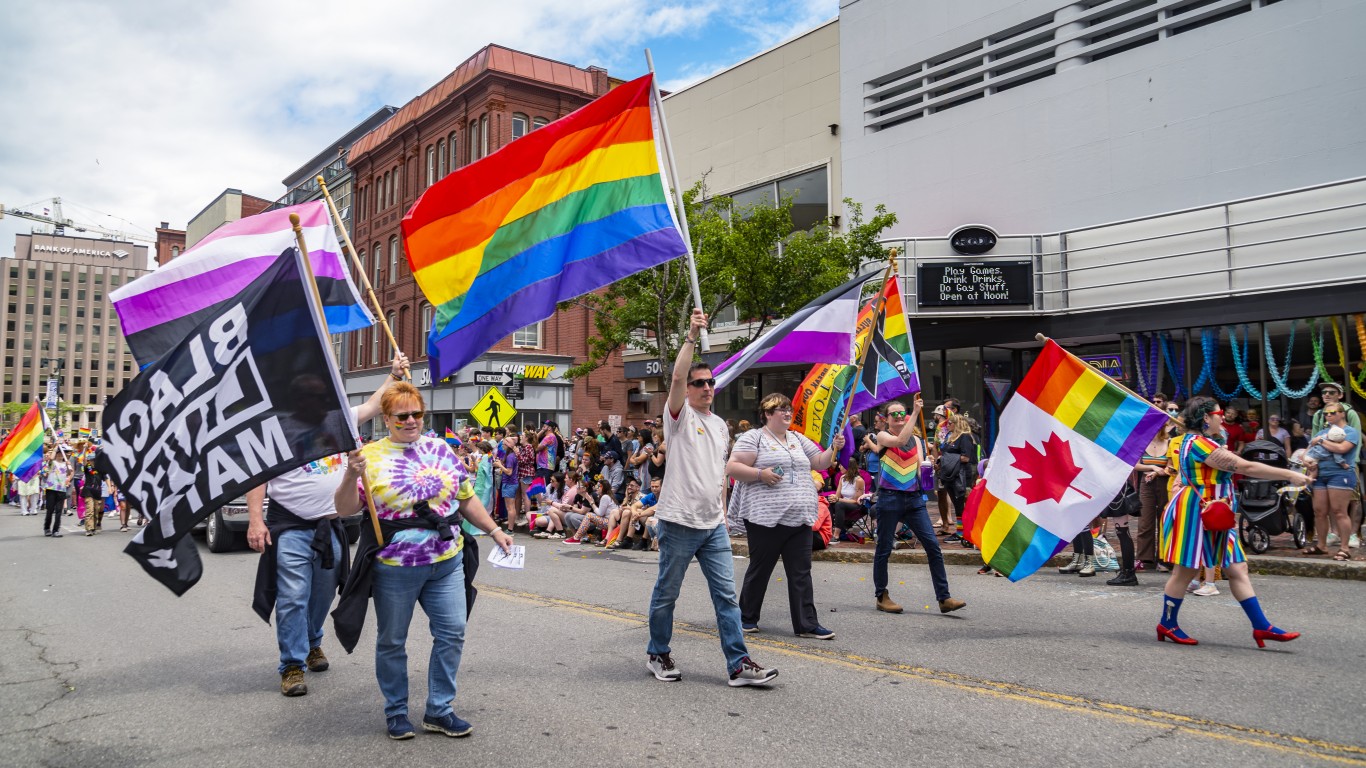
4. Maine
> LGBTQ equality score: 39.5 out of 43.5
> Sexual orientation policy score: 19 out of 20.5 (4th highest)
> Gender identity policy score: 20.5 out of 23 (7th highest)
> Est. LGBTQ population (18+), July 2022: 56,000 (4.9% of 1,137,442)
> LGBTQ residents aged 25+ raising children: 21% (7th lowest – tied)
[in-text-ad]
4. New York
> LGBTQ equality score: 39.5 out of 43.5
> Sexual orientation policy score: 18.5 out of 20.5 (5th highest)
> Gender identity policy score: 21 out of 23 (4th highest)
> Est. LGBTQ population (18+), July 2022: 800,000 (5.1% of 15,687,863)
> LGBTQ residents aged 25+ raising children: 22% (9th lowest – tied)
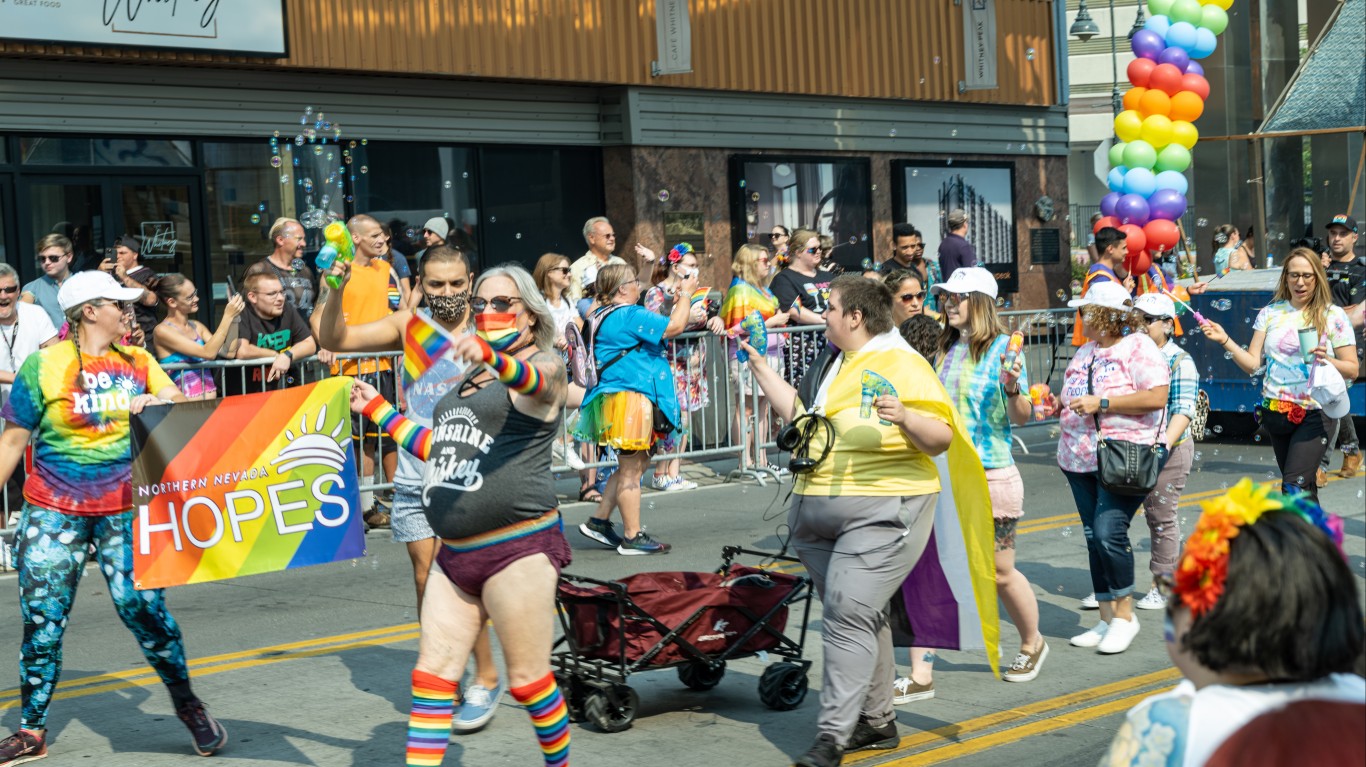
3. Nevada
> LGBTQ equality score: 40.5 out of 43.5
> Sexual orientation policy score: 20 out of 20.5 (2nd highest)
> Gender identity policy score: 20.5 out of 23 (7th highest)
> Est. LGBTQ population (18+), July 2022: 137,000 (5.5% of 2,487,994)
> LGBTQ residents aged 25+ raising children: 22% (9th lowest – tied)
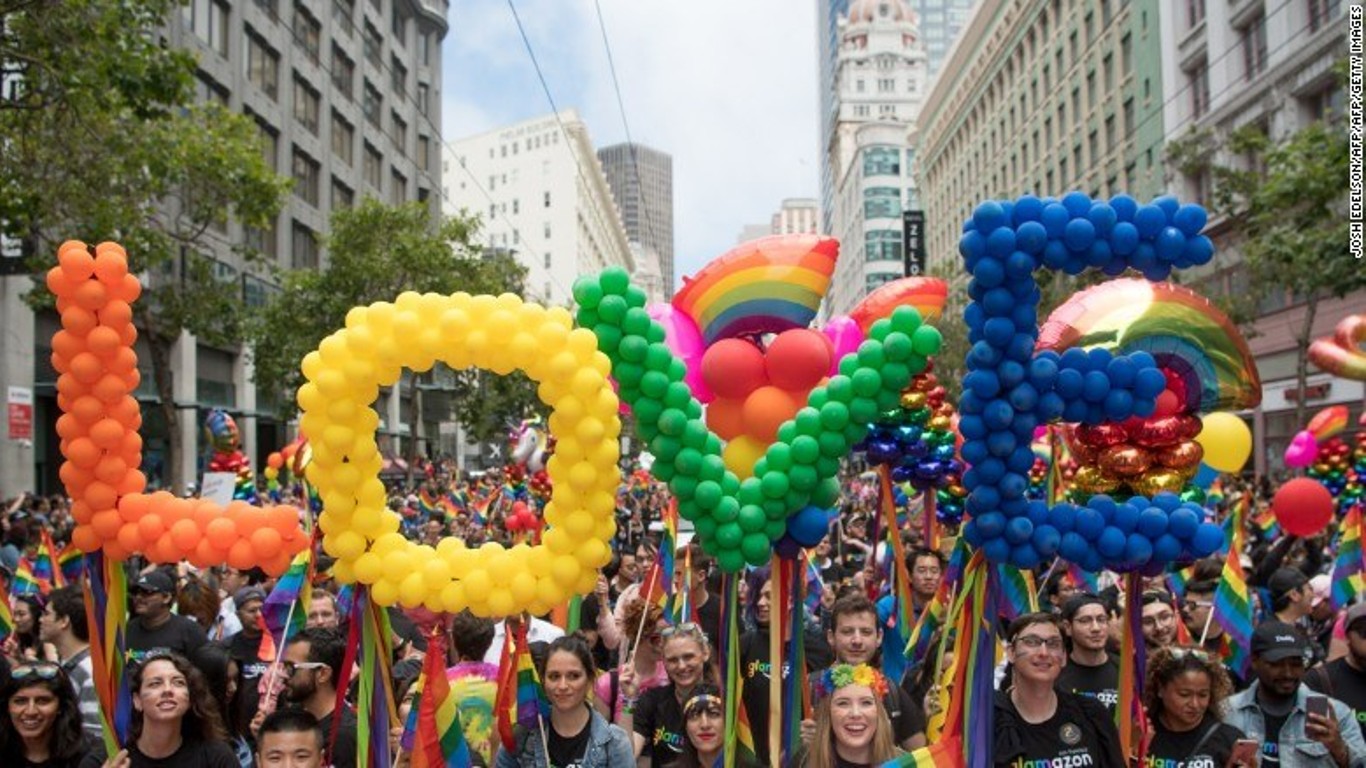
2. Colorado
> LGBTQ equality score: 42.5 out of 43.5
> Sexual orientation policy score: 20.25 out of 20.5 (the highest)
> Gender identity policy score: 22.25 out of 23 (2nd highest)
> Est. LGBTQ population (18+), July 2022: 213,000 (4.6% of 4,624,351)
> LGBTQ residents aged 25+ raising children: 25% (17th lowest – tied)
[in-text-ad-2]

1. California
> LGBTQ equality score: 42.75 out of 43.5
> Sexual orientation policy score: 20 out of 20.5 (2nd highest)
> Gender identity policy score: 22.75 out of 23 (the highest)
> Est. LGBTQ population (18+), July 2022: 1,618,000 (5.3% of 30,523,315)
> LGBTQ residents aged 25+ raising children: 24% (14th lowest – tied)
Methodology
To find the best and worst states for LGBTQ people, 24/7 Wall St. reviewed LGBTQ Equality by State from Movement Advancement Project, an independent, nonprofit think tank. MAP looked at state and local laws and policies that protect or harm LGBTQ people, assigning a value to each and tallying the scores. Harmful or discriminatory policies receive negative scores, while protective and inclusive policies receive positive scores. A state’s total possible tally score can range from -30.5 to +43.5, as of May 11, 2023. States are ranked from worst to best.
To calculate a rough estimate of the number of LGBTQ people aged 18+ in each state, 24/7 Wall St. used estimated percentages of LGBT people in each state from the Williams Institute analysis of surveys conducted by Gallup Polling (2012-2017) and the recent adult population totals from the U.S. Census Bureau as of July 2022.
The percentage of LGBTQ individuals who raise children come from MAP and are also from the Williams Institute.
Credit Card Companies Are Doing Something Nuts
Credit card companies are at war. The biggest issuers are handing out free rewards and benefits to win the best customers.
It’s possible to find cards paying unlimited 1.5%, 2%, and even more today. That’s free money for qualified borrowers, and the type of thing that would be crazy to pass up. Those rewards can add up to thousands of dollars every year in free money, and include other benefits as well.
We’ve assembled some of the best credit cards for users today. Don’t miss these offers because they won’t be this good forever.
Flywheel Publishing has partnered with CardRatings for our coverage of credit card products. Flywheel Publishing and CardRatings may receive a commission from card issuers.
Thank you for reading! Have some feedback for us?
Contact the 24/7 Wall St. editorial team.
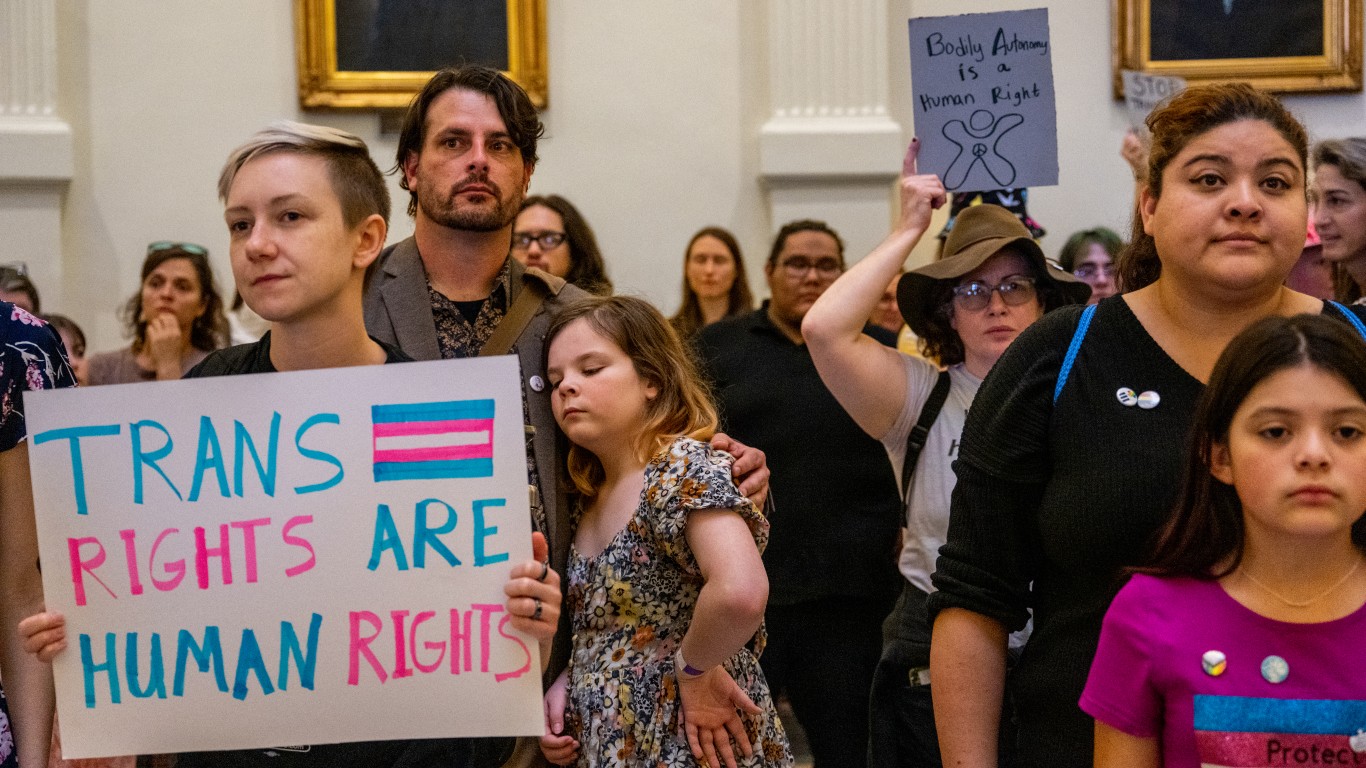 24/7 Wall St.
24/7 Wall St.
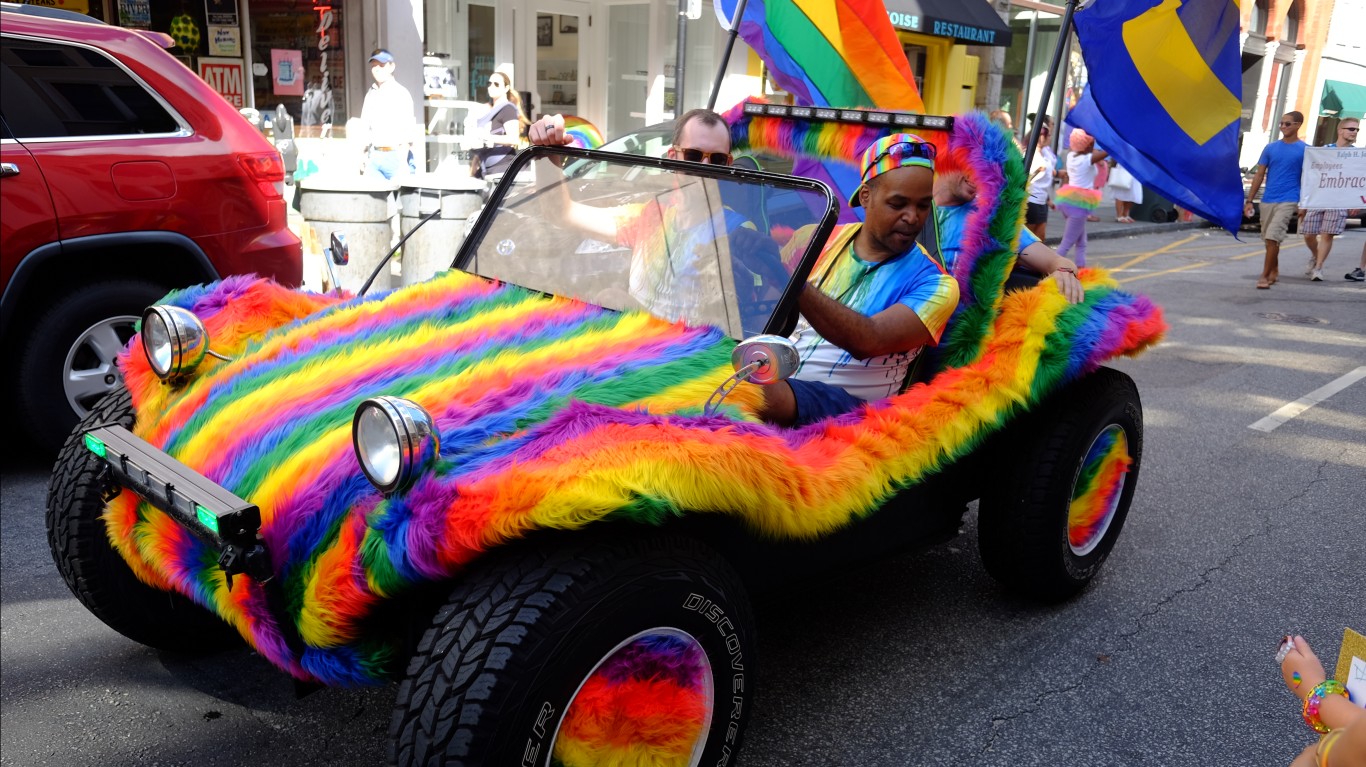
 24/7 Wall St.
24/7 Wall St.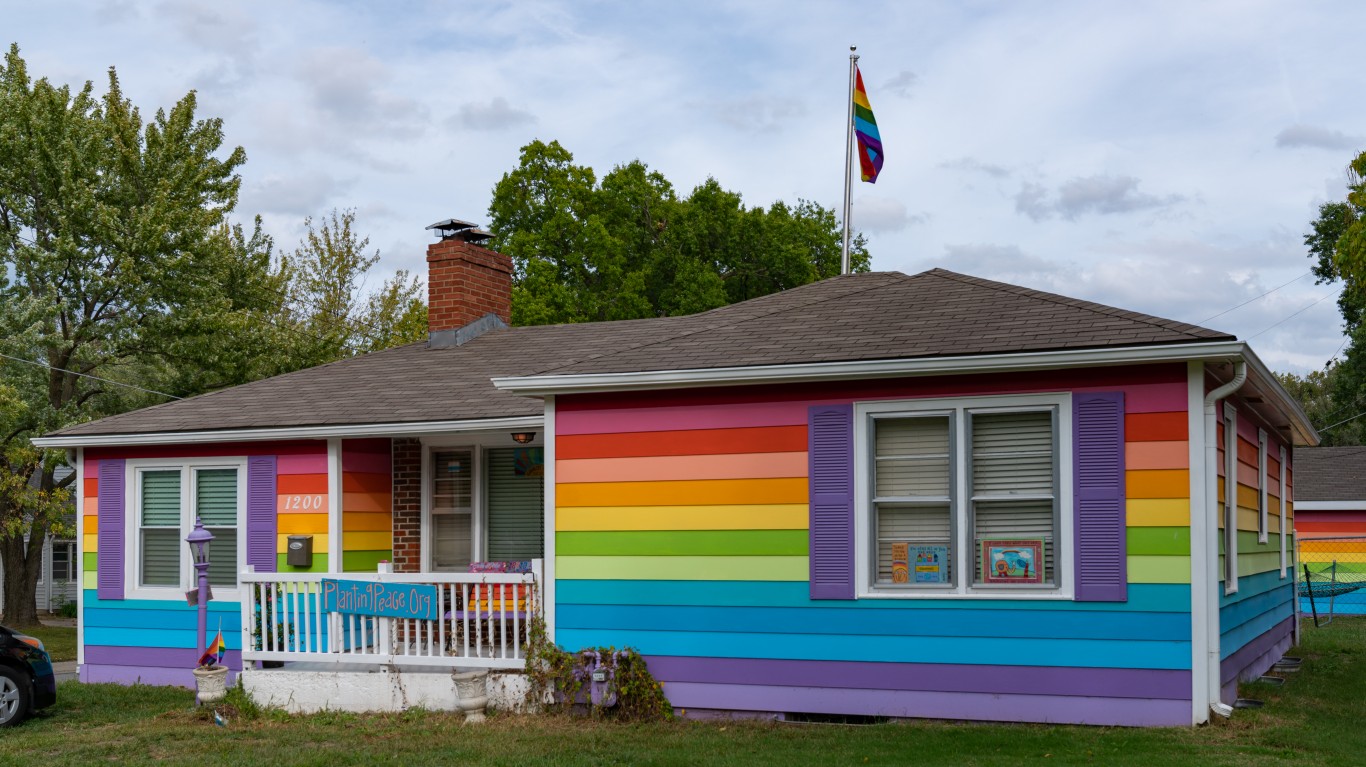

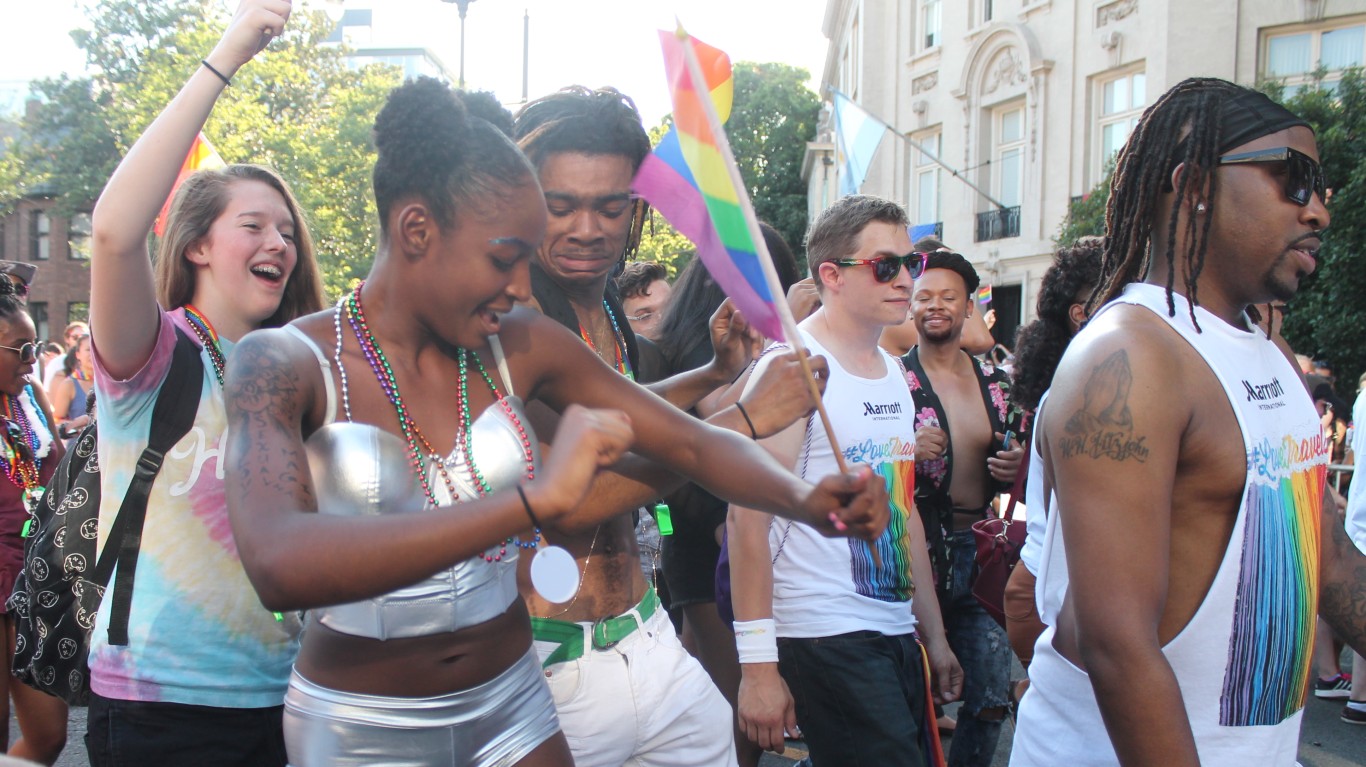
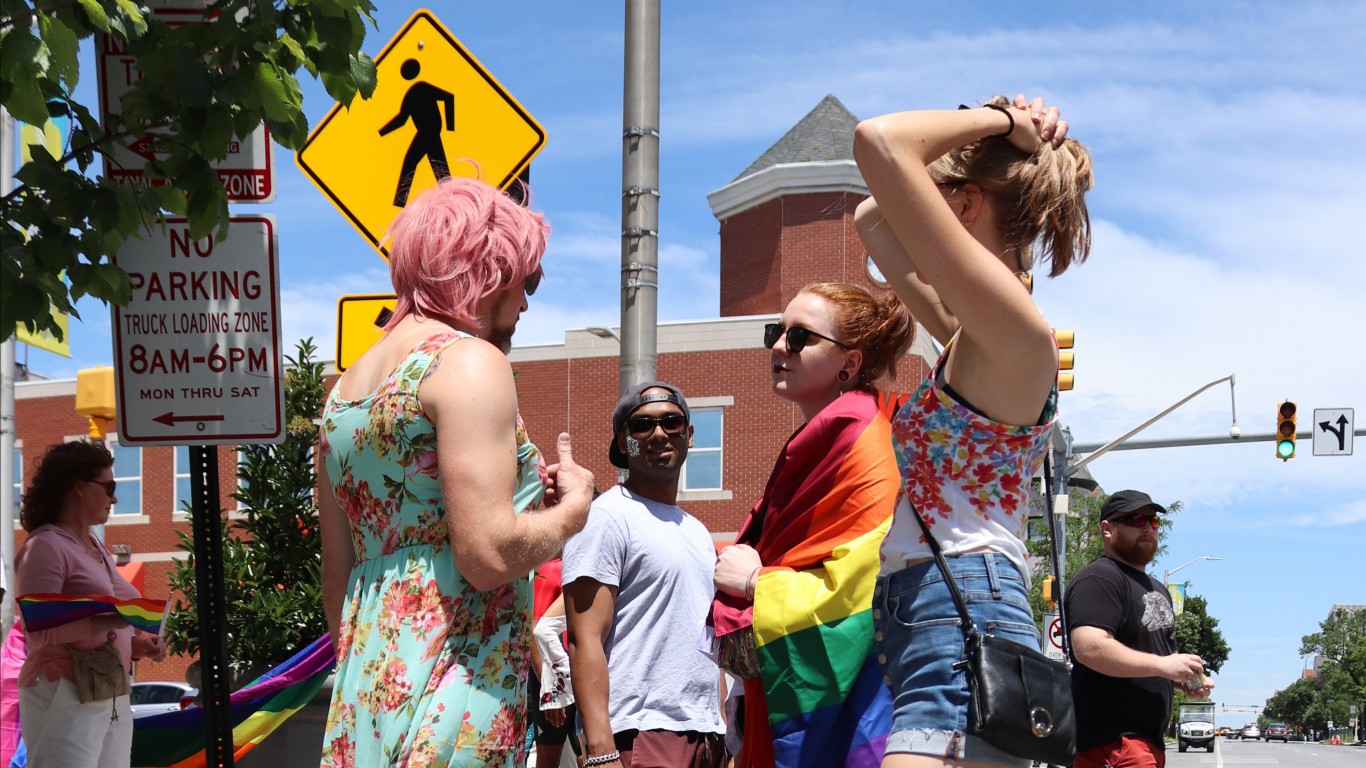
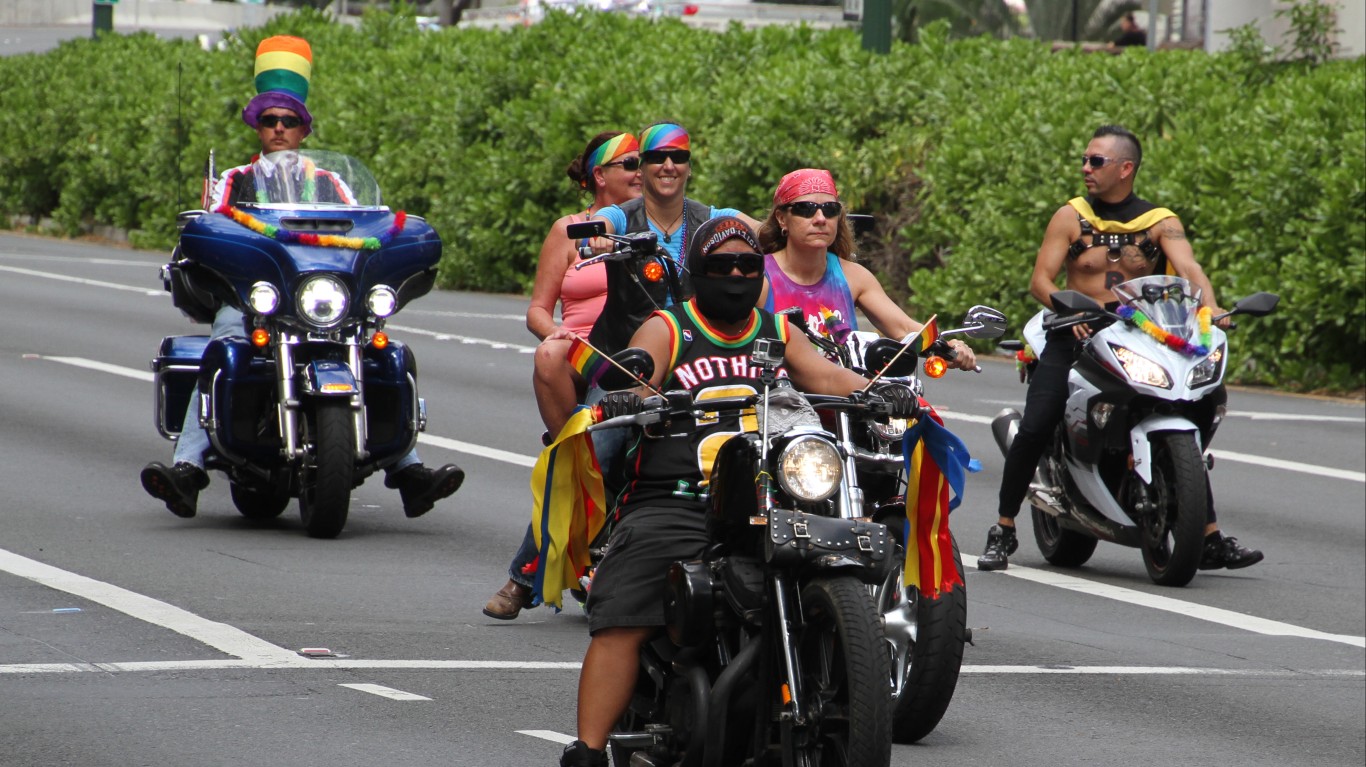
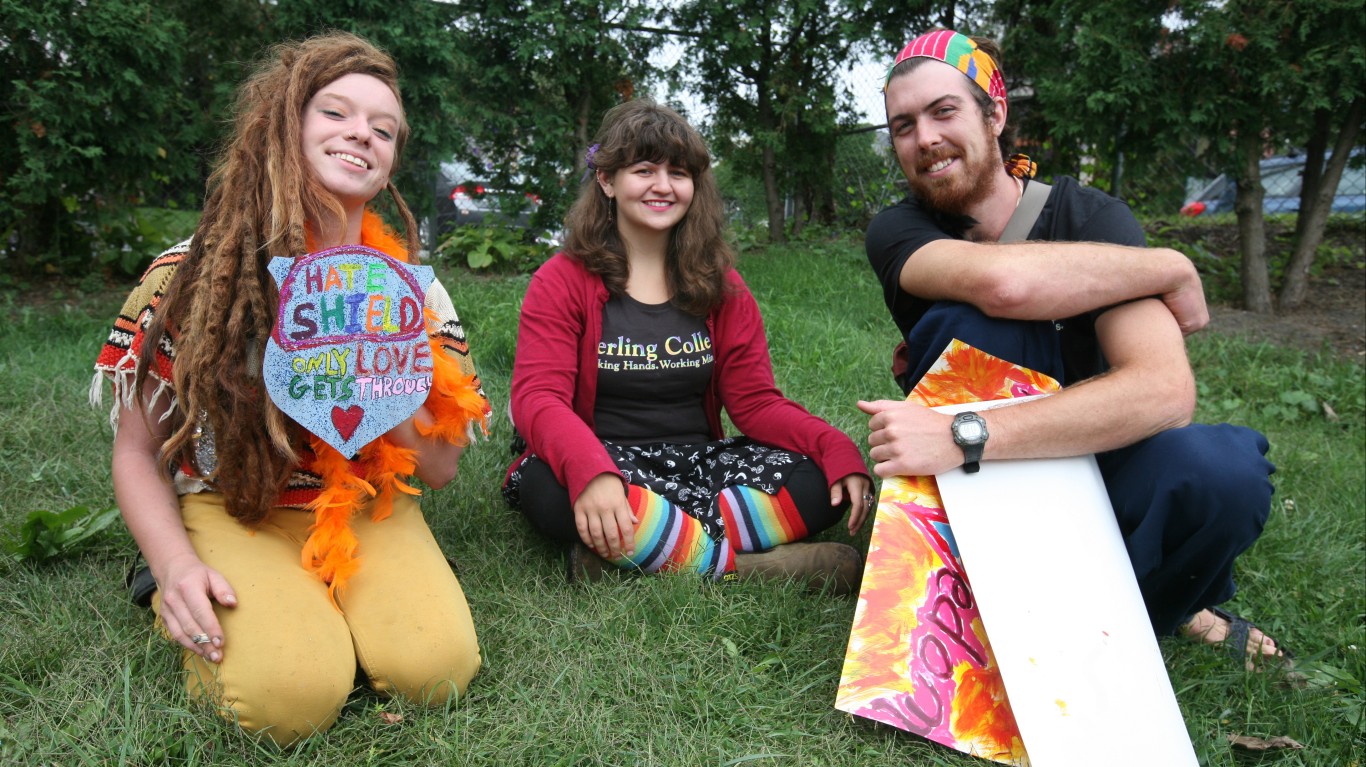
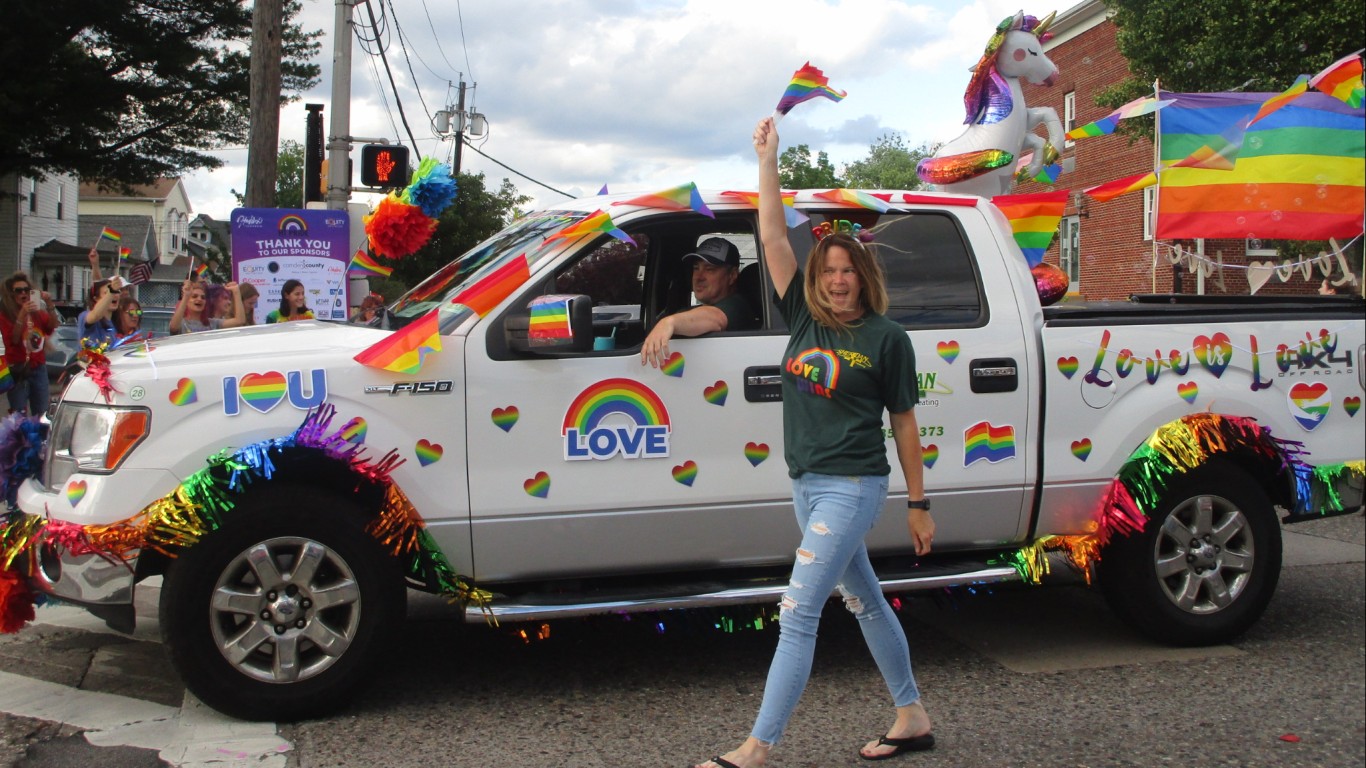
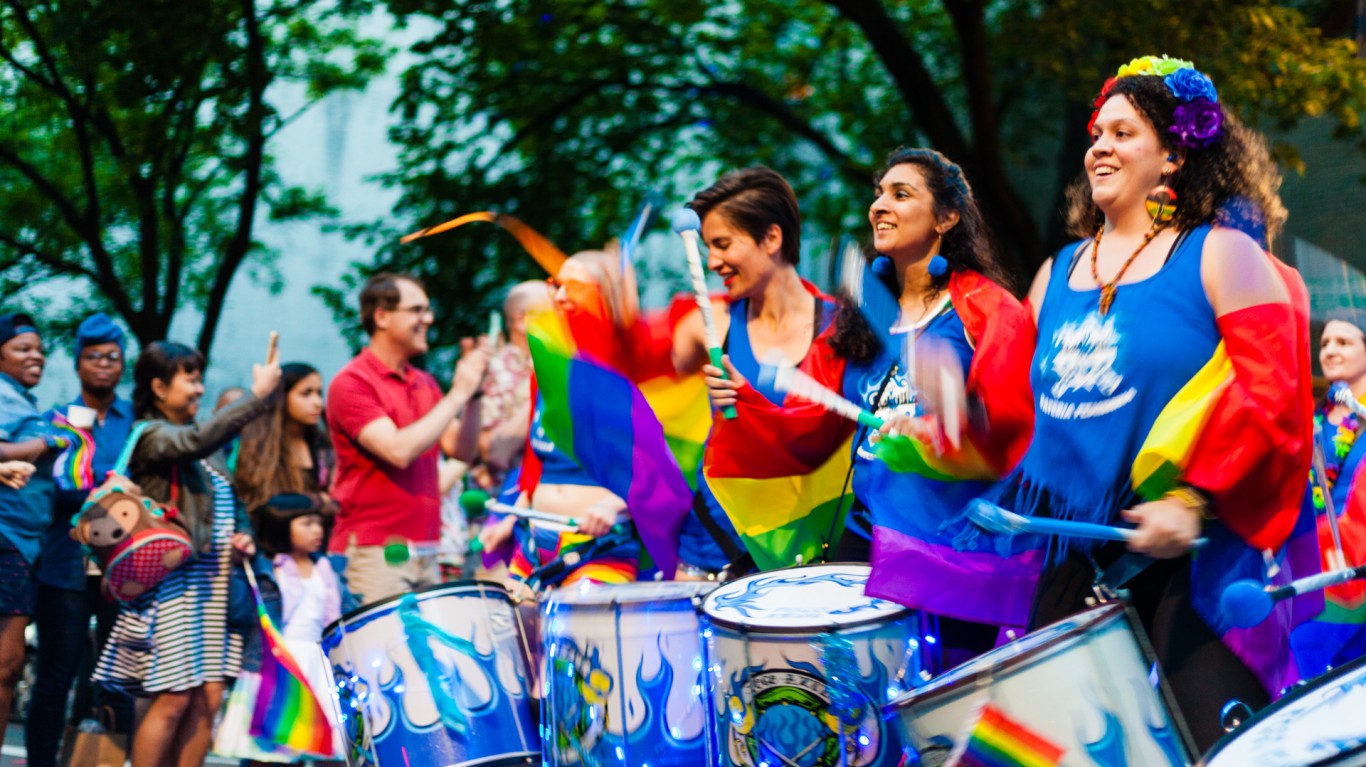
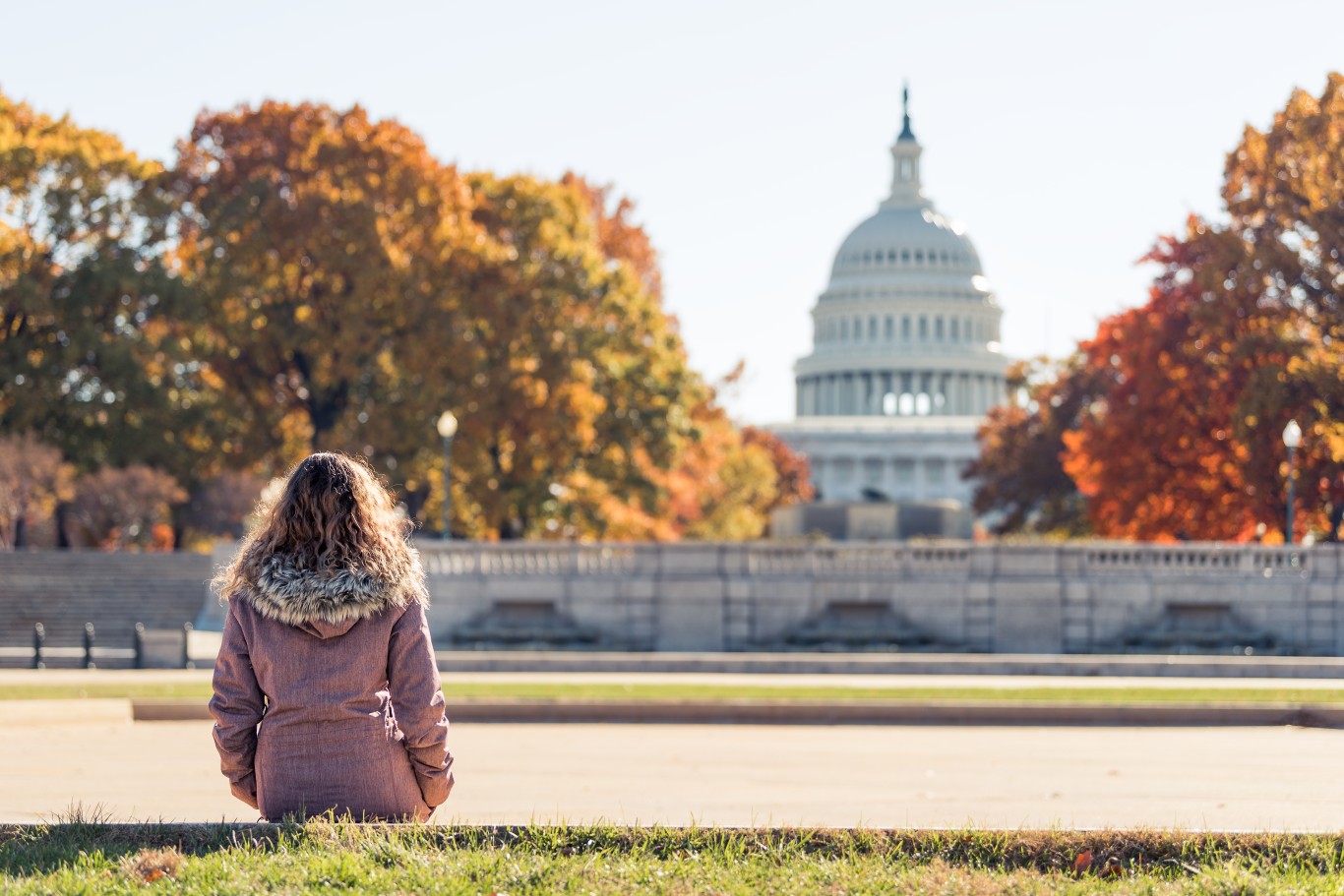 24/7 Wall St.
24/7 Wall St.